March 29, 2011
Il ritorno d’Ulisse in patria, ENO
Mythic and epic tales often seem designed to offer a veiled explanation of an essential truth, as they attempt to use the lessons of the past to make sense of a difficult present. The plot of Il ritorno d’Ulisse is drawn from Homer, filtered through Virgil, and Monteverdi’s musical retelling certainly invokes the power of myth. But, as Penelope awaits the return of her long-lost husband, Ulisse, from the Trojan Wars, the concerns and emotional dramas seem much more human than divine.
Indeed, Andrews’ production commences with a shocking parade of ‘Human Frailty’, crudely masked and brutality dragged, like a dog or abused prisoner of war, onto the stage by his cruel masters, Time, Love and Fortune. The message is clear: man is pitifully frail, a mere plaything of the gods. And, man’s infinite suffering at the hands of indifferent deities is unambiguously portrayed in the unfolding drama. The anguish and frustration of the protagonists is unceasingly evident as we peer through the transparent walls of designer Börkur Jónsson’s striking set, which continuously revolves to allow for microscopic scrutiny of the characters’ agonies.
The monochrome set pitilessly exposes mankind’s defencelessness. Dusty sheets roll back to reveal Penelope’s glass-sided, pseudo-loft space, equipped with cocktail bar, cinema room and other requisites of modern luxury living. But, beneath the civilised veneer lies a brutal reality. Smart-suited suitors leer and lounge in louche fashion; Ulisse’s faithful old nurse, Ericlea, serves up supper, only for her culinary efforts to be flung in fury at the transparent walls; the television screen relentlessly relays brutal reports from the battlegrounds of war. Penelope paces and prowls, tended by two considerate and compassionate maids who try to shield her from the sexual avariciousness of the lewd suitors.
Under harsh spotlights, the inhabitants clutch and grasp at the walls. The pristine glass is soon stained and smeared with food and drink, and ultimately splattered with human flesh and blood.
Nothing escapes the voyeuristic gaze. Just as we witness every private agony and torment, so the inhabitants of the house stare inexorably at the action which unfolds outside, as characters step through the glass door onto the front of the stage. The sufferings within mirror those without, and this is enhanced by some effective visual doubling: the Goddess Minerva, Ruby Hughes, is dressed as Penelope’s double, emphasising her power as she controls and manipulates her human puppets.
The ubiquitous psychological angst is also conveyed in the form of magnified images which are projected onto two vast screens to left and right. However, the singularity of emotional affekt and the unchanging nature of the visual expressions quickly reduces the dramatic impact of these unremitting close-ups of grief and distress; as the opera progresses, the contorted facial gestures become a distraction.
Andrews’ direction is tireless in its attention to detail, if somewhat tiring in its demands on the audience, who face quite a challenge to comprehend, even observe, every nuance, motif and metaphor. However, the cast are uniformly committed and intense, communicating Christopher Cowell’s superb translation with vigour if not always with equal clarity of diction.
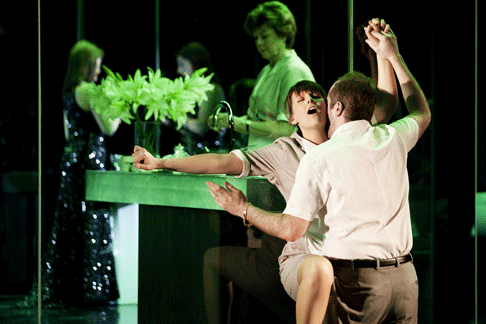 Katherine Manley as Cupid and Thomas Walker as Eurimaco
Katherine Manley as Cupid and Thomas Walker as Eurimaco
Neither Tom Randle nor Pamela Helen Stephen are early-music ‘specialists’ but, as the divided lovers, Ulisse and Penelope, they bring much dramatic insight and conviction to their respective roles.
Randle summons all his dramatic and musical resources, and powerfully exploits his muscular physique, to convey the nature and degree of the emotional suffering and transformation undergone by the conquering hero. A ravaged war hero, broken by the ruthless events he has witnessed and the vicious acts he has performed, driven to the very edge of sanity, Ulisse wanders in the margins, cloaked like a wandering hobo, draped in shadows. A pathetic victim, urinated upon by the social underclass, Randle wins our unquestioning sympathy, his beautiful tenor possessing a slight grain which keeps sentimentality at bay. Consequently, the Tarantino-esque savagery with which he later despatches of his ‘rival’ suitors is appalling and disturbing, following the fragile pathos of his return to his homeland. And, the amorality of the senseless violence is further emphasised by the fact that Ulisse’s blood-thirsty revenge is documented by a newsreel cameraman, his focus steady and sure, untroubled by the horrors of the scene he is recording. Randle retreats to the shower room in an attempt to wash away the blood and gore, and to cleanse his emotional wounds, but it is clear that he returns to his wife a damaged man, perhaps irrevocably so, and the reunion with his long-suffering wife is tinged with wretchedness.
The lament of an abandoned woman was a standard topos in early seventeenth-century opera, and while Pamela Helen Stephen does not have an especially distinctive voice, she is perfect for the role of enduring but dignified victim that Andrews envisages. She has a particularly affective lower register, and as her voice descends it intertwines with emotional force with the instrumental fabric. Stephen’s delivery of the recitative is flexible and confident. Penelope’s ‘refusal’ to sing in an aria form becomes a potent metaphor for her emotional state as she refuses to give way to love; only when she recognises Ulisse can she express herself in song, and Stephen’s rendering of Penelope’s aria, ‘Illustratevi, o cieli’, is a powerful and climactic moment as her distress is transmuted to joy.
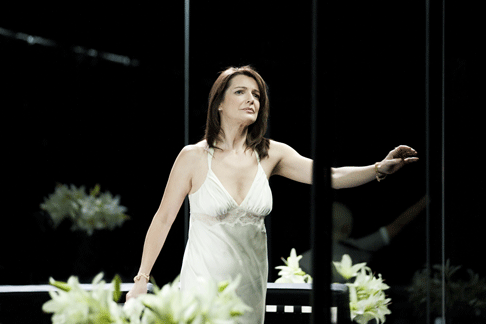 Pamela Helen Stephen as Penelope
Pamela Helen Stephen as Penelope
Ruby Hughes is a sensuous and assertive Minerva, domineering and somewhat sinister — Ulisse meets the goddess in the form of a small, rather unnerving, ventriloquist’s dummy. Hughes powerfully conveys the Goddess’s pride and hauteur as she manipulates the ‘puppets’ in her control, before she too succumbs to emotional breakdown and collapse. Here, Andrews parts company with the myth, for traditionally Minerva is associated with culture and wisdom, rather than the lustful licentiousness of Andrews’ conception. And while one might accept this re-imagining of Minerva, dressed in a slinky, sequinned black gown, it’s harder still to understand why she later smears herself with blood, and douses herself in white talcum powder …
One of the finest performances of the evening comes from Thomas Hobbs, as Ulisse’s son, Telemacho. Hobbs has a strong, focused tenor voice, but one which is sufficiently flexible to convey emotions ranging from grief to self-composure, hope to wonderment, and his reunion with Ulisse is immensely moving.
Nigel Robson, as the shepherd Eumete, presents a touching portrayal of a loyal servant. And, his interaction with Brian Galliford’s gluttonous, parasitic Iro is superb. Living off the wealth of the suitors, Iro appears at several points in Il ritorno as a figure of fun: he is mocked by Eumete in Act I (but not without himself making some pointed comments on the pastoral life) and is thrashed by Ulisse in Act II. However, his scene at the beginning of Act III takes on a different edge, and Galliford’s voice surpasses the comic to take on a tragic tone as Iro veers towards madness, providing a significant focus for the opera as a whole.
The inclusion of scurrilous and comic characters is just one of the features which were, by 1639, standard in Venetian public opera. Many were drawn from the theatre — indeed, Iro is reminiscent of a Shakespearian Fool — especially the commedia dell’arte, such as nagging nurses, flirtatious servants, and regular recourse to magic and disguise. But one cannot help but feel that Andrews is stretching the coarseness of these dramatic predecessors a step too far when Katherine Manley’s Melanto removes her underwear and lifts her skirt, to facilitate her lover Eurimaco’s (Thomas Walker) sexual advances. Such vulgarities among the minor characters risks distracting from the high quality of their singing: Diana Montague is a fine Ericlea, and among the suitors, Samuel Boden’s Anfinomo manages to rise above the exaggerated crudeness of the action.
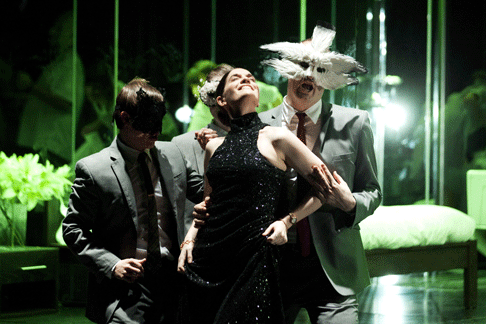 Ruby Hughes as Fortune and the Three Suitors (Antinoo: Francisco Javier Borda, Pisandro: Iestyn Morris and Antinomo: Samuel Boden)
Ruby Hughes as Fortune and the Three Suitors (Antinoo: Francisco Javier Borda, Pisandro: Iestyn Morris and Antinomo: Samuel Boden)
Conductor Jonathan Cohen plays a major role in maintaining coherence and momentum. Leading a 13-piece ensemble, he drives the music forward; he has an intuitive sense of the rhythmic vitality of this idiom, propelled as it is by muscular bass lines, and achieves seamless transitions between the recitative and arioso numbers which form a mosaic structure of speech- and song-like fragments. The instrumental sinfonias and ritornellos are well-paced, and the timbre of viola da gamba, lirone, theorbo and bassoon, at times rough and nasally, complements the earthiness of the events on stage.
In this striking production, Andrews offers us much to cogitate and digest — perhaps a tad too much. For Venetian operas of the mid-seventeenth century were essentially convivial entertainments fulfilling specific social, economic and cultural functions. While our attempts to find deeper meanings and fundamental statements on the human condition within them may be somehow essential to the way in which we wish to relate to opera, we may be in danger of fundamentally missing the point.
For, although she is undoubtedly besieged by Time, Fortune and Love, Penelope is not so humanly frail as to give in to them: indeed, the whole point of the opera is that her virtue and constancy provide weapons against Time and Fortune, and that her love is not the flighty, inconstant kind that is represented by Love in the Prologue. In this sense, the action of the opera actually disproves or counters the prologue. Andrews’ production presents a sustained reading — at times intriguing, elsewhere distracting — but is it one which is true to Monteverdi’s score?
Claire Seymour
image=http://www.operatoday.com/The_Return_of_Ulysses_4.gif image_description=Tom Randle as Ulisse and Brian Galliford as Iro [Photo by Johan Persson courtesy of English National Opera] product=yes product_title=Claudio Monteverdi: Il ritorno d’Ulisse in patria product_by=Human Frailty: Iestyn Morris; Time: Francisco Javier Borda; Fortune: Ruby Hughes; Cupid: Katherine Manley; Penelope: Pamela Helen Stephen; Ericlea: Diana Montague; Melanto: Katherine Manley; Eurimaco: Thomas Walker; Ulisse: Tom Randle; Minerva: Ruby Hughes; Eumete: Nigel Robson; Iro: Brian Galliford; Telemaco: Thomas Hobbes; Three Suitors—Antinoo: Francisco Javier Borda, Pisandro: Iestyn Morris, Antinomo: Samuel Boden. Conductor: Jonathan Cohen. Director: Benedict Andrews. Set Designer: Börkur Jónsson. Costume Designer: Alice Babidge. Lighting Designer: Jon Clarke. English National Opera at the Young Vic Theatre, London, Thursday 24th March, 2010. product_id=Above: Tom Randle as Ulisse and Brian Galliford as IroAll photos by Johan Persson courtesy of English National Opera
March 28, 2011
Le Comte Ory, Metropolitan Opera
You could make a case for adding supernatural scamps like Der Vampyr and Tannhäuser to the list. The hero may be a rogue—in fact, rogue is his job description—and may even be a cutthroat or worse, but he’s a lovable fellow for all that. And he almost never gets to home plate with the ladies whose hearts he flutters; the censors wouldn’t have stood for it. Thus the joke of Gilbert and Sullivan’s spoof in The Pirates of Penzance: Their chorus-full of reckless rogues lust “to be married with impunity” to the bevy of helpless females they are about to abduct. (Is it coincidence that most of the sexy scoundrel operas are French? No.)
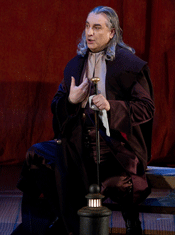 Michele Pertusi as The Tutor
Michele Pertusi as The Tutor
The censors wouldn’t have stood for it then, but there are no censors now, and opera directors are all for full disclosure. This mars Bartlett Sher’s colorful if bare-bones staging of Le Comte Ory for the Met. Consider the final trio: Ory, our scoundrel, has disguised himself as a nun in order to enter Countess Adèle’s bed in her darkened chamber. Unbeknownst to him (but obvious enough to us), Adèle’s young suitor, Isolier, is also present, and in fact the Count is embracing Isolier as Isolier embraces Adèle. If this seems a bit racy for 1828, even in Paris, ne vous-inquiètez pas: Isolier is played by a mezzo soprano. Audiences didn’t mind watching a man fiddle with a boy so long as the boy was obviously a woman. (The first time I saw this opera, Lucky Pierre—sorry, Isolier—was played by a countertenor; he seemed to be enjoying the situation.)
But in Sher’s production, all three persons scramble around each other among the bedclothes as if this were just an ordinary three-way with no story to tell, and it is impossible for the Count not to be aware that he is in bed with two other people. Adèle, too, should not be aware of what is going on; here she’s a merry participant. It may seem a small point, and everybody around me found the slapstick hilarious, but the premises of farce must be taken seriously for the mad machine to work properly. Either Joyce DiDonato is a man or she isn’t; if she isn’t, why does Adèle hope to marry her? If she is, why does the skirt-chasing Count enjoy being in bed with him? It’s as if Lucy schemed to divorce Desi and demanded custody of his band: It violates the clear farcical contract for which we have been so carefully set up.
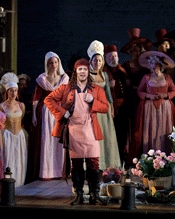 Stéphane Degout as Raimbaud
Stéphane Degout as Raimbaud
Sher, as in his previous Met shows, Barbiere and Hoffmann, is always willing to dump the plot to insert a dumb joke; this was also true in his disastrous staging of Women on the Verge of a Nervous Breakdown. He only seems capable of theatrical discipline if the piece is, like South Pacific, sacrosanct, guarded by those who can keep him in line. He has no theatrical clarity of his own. Is this sort of anything-for-a-laugh mayhem what Peter Gelb means when he refers to a “new realism” in the opera house?
The singers have been encouraged not to play this charming piece straight. I would find the evening pleasanter (and probably funnier) if Diana Damrau, a fine singer as well as a fine comic actress, sang the dizzy Countess’s fruity tunes with a bit more attention to proper line and with fewer wildly mugged high notes, and if Juan Diego Flórez’s nasal tenor, never the most sensuous of instruments, were not quite so dry. He is choosing roles lately that do not exhibit his extraordinary virtuosity, and his is not an instrument to make it in bel canto otherwise. There are many far prettier tenor voices around.
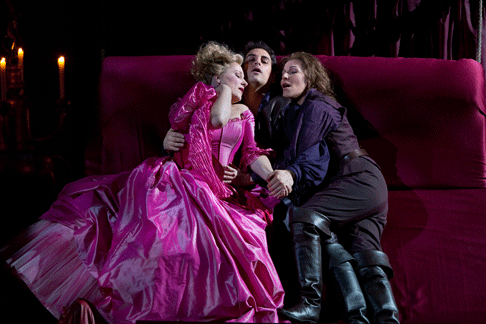 Diana Damrau as Countess Adle, Joyce DiDonato as Isolier, and Juan Diego Flórez as Count Ory
Diana Damrau as Countess Adle, Joyce DiDonato as Isolier, and Juan Diego Flórez as Count Ory
What, I wonder, would Rothenberger and Gedda have made of the bedroom trio? With, say, Teresa Berganza as Isolier? I can’t help thinking they’d have each contrived to keep one foot on the floor, in old-time Hollywood fashion, but they would still have been funnier than Sher’s staging, and they would have sounded like a glimpse of heaven.
Joyce DiDonato, as Isolier, is a lovely performer who does not let her farce-making get in the way of torrents of beautiful Rossini, as heartfelt as they are pure. She is the reason to visit Le Comte Ory and the reason to linger to the very end. Susanne Resmark revealed a most attractive alto voice with more to display than was evident here in the Margaret Dumont-like housekeeper role. Michele Pertusi was all that could be desired as the Tutor and Stéphane Degout filled our grateful ears with dark baritone during his drinking song. Maurizio Benini kept the orchestral sound low so as not to interfere with singers’ audibility, though as Sher (as usual) pushed them all to the edge of the stage apron, this was probably unnecessary. In the old days, and not so very old either, singers could fill the Met from mid-stage and revel in the filling.
John Yohalem
image=http://www.operatoday.com/COMTE_ORY_Florez_as_title_r.gif image_description=Juan Diego Flórez as Count Ory (disguised as the Nun) [Photo by Marty Sohl courtesy of The Metropolitan Opera] product=yes product_title=Gioachino Rossini: Le Comte Ory product_by=Comtesse Adèle: Diana Damrau; Isolier: Joyce Di Donato; Comte Ory: Juan Diego Flórez; Ragonde: Susanne Resmark; Tutor: Michele Pertusi; Raimbaud: Stéphane Degout. Production by Bartlett Sher. Metropolitan Opera chorus and orchestra conducted by Maurizio Benini. Performance of March 24. product_id=Above: Juan Diego Flórez as Count Ory (disguised as the Nun)All photos by Marty Sohl courtesy of The Metropolitan Opera
March 27, 2011
Orlando Furioso, London
Vivaldi’s first encounter with Orlando was in 1713 when he mounted Ristori’s Orlando Furioso and his own Orlando Finto Pazzo in Venice; the Ristori was a success, his opera less so. In 1727 Vivaldi returned to the subject, this time setting the same libretto that Ristori had used. Not long afterwards, in the 1730’s, Handel would use the same episodes to created two of his greatest operas, Alcina and Orlando.
But whereas Handel created two operas, Vivaldi crammed both plots into a single breathless romp. Handel’s operas are works of great depth and sophistication, whereas Vivaldi’s aim seemed to be to entertain; the drama runs at high speed, the arias are short and lively, the plot mixes magic and humour with occasional shades of drama.
Having given us Handel’s Alcina in December, the Barbican’s Great Performers season on Saturday 26th March brought us Jean-Christophe Spinosi and his Ensemble Malthus in Vivaldi’s Orlando Furioso. The performance originated at the Theatre des Champs Elysee, but as is the way of these things illness forced some cast changes so that Daniela Pini and Franziska Gottwald joined the cast at short notice. This meant that Pini and Gottwald sang from the score whereas the remainder of the cast were off the book.
By combining Alcina and Orlando, Vivaldi ended up with a large number of characters, 7 in all, even though Alcina’s sister is mentioned but never appears and the character of Dorinda (present in Handel’s Orlando) is entirely absent. Vivaldi asks a lot of his singers, his arias though generally short in length are very much in the style of his instrumental concerti. Each singer was presented with an opening aria which used a series of variations on the theme of bravura up-tempo virtuosity; each toe-tapping in its way, with brilliant string accompaniment, but fatally lacking in extremes of variety or emotion. It was only when we were two thirds of the way through act 1 that the tempo changed and Philippe Jaroussky’s Ruggiero entered with an aria of haunting lyrical beauty.
Act 1 involved a great deal of introduction and explanation. It was in Act 2 that the real drama started, when Victoria Cangemi’s beautifully lyrical, if scheming, Angelica united with Daniela Pini’s nicely hesitant Medoro. Having been pursued by Marie-Nicole Lemieux’s Orlando, Angelica has led Orlando on and tricked him. Needless to say Orlando goes mad.
Vivaldi’s way the drama here was less sure than Handel’s. When Angelica pretended to respond to Orlando’s attentions Vivaldi gave her an aria of great lyrical beauty, finely sung by Victoria Cangemi; but entirely lacking in an iota of irony or a feeling that Angelica doesn’t actually mean what she says. Marie-Nicole Lemieux was a one woman tour de force as the hero Orlando, a series of bravura arias tremendously sung led to Orlando’s mad scene which closed act 2.
Parallel to this Alcina, played with charm and amused detachment by Franziska Gottwald, was busy captivating Jaroussky’s lyrical and slightly wimp-ish Ruggiero, in turn pursued with amazonic charm by Kristina Hammarstrom’s Bradamante (Ruggiero’s beloved, disguised as a man).
The libretto left the singers little time to create a three dimensional character, they were only able to provide a sketch, usually accompanied by some brilliant singing. Gottwald was notable for the way she suggested Alcina’s charm and the loneliness behind, a woman able to get any man she wanted but unable to form a real relationship. It was her aria towards the end of act, movingly sung by Gottwald, where we first got some real depth of feeling.
In act 3, the two plots collided as Orlando in his madness destroyed the temple holding the key to Alcina’s power; (a strange confusion of operatic plots rather as if Lucia di Lammermoor suddenly appeared and killed Macbeth). Spinosi encouraged Lemieux to move from bravura to over the top in Orlando’s act 3 mad scenes, the style veering towards the 19th century mad scene and even, fatally, G&S’s Mad Margaret. This was an occasion when less might have been more.
Throughout proceedings Gottwald’s Alcina kept her poise and left us in an aura of sadness rather than heart rending grief. Interestingly Angelica was taken to task for the way she had toyed with Orlando’s affections and led him on; a moralising not often found in baroque opera.
The rather protracted tidying up of loose ends in act 3 made me rather admire the way Handel and his librettists often took the blue pencil to final acts and speeded things up; that certainly needed doing here.
Christian Senn was the only lower voice, another knight charmed by Alcina; he seemed at times the only voice of reason.
Though Vivaldi did use trumpets, horns and oboes in the orchestra, he did so extremely sparingly so that the predominant orchestral colour was the strings. Spinosi and his ensemble, quite a large group numbering 28 strings, did full justice to Vivaldi’s brilliant orchestra accompaniments and tuttis.
The opera was presented in what has become the standard for this style of concert performance, with singers at the side of the stage, making generally correct entrances and exits, all the women playing men were helpfully in trousers. It certainly helped the drama that most of them were singing off the book. But more importantly we had singing of such a high order that when Vivaldi did use the music to create drama, we felt the benefit of it. In terms of sheer vocal quality this was an evening hardly to be faulted and the enthusiasm of both singers and ensemble seemed infectious.
Vivaldi’s Orlando Furioso is a long opera; we had over 3 hours of music with a single 20 minute interval in the middle of act 2. As the evening started at 6.30 and finished at 10.10pm, I could not help thinking that Vivaldi’s act structure could have been respected and the piece performed with 2 intervals.
Vivaldi’s opera succeeds on its own terms, that is it entertains; in fact it does so royally. We might wish for Handel’s greater depth, but Vivaldi’s romp is fun especially when presented with such skill as it was here.
Robert Hugill
image=http://www.operatoday.com/Orlando_Furioso_9.gif image_description=Orlando Furioso by Gustave Doré [Source: Wikipedia] product=yes product_title=Antonio Vivaldi: Orlando Furioso (concert performance) product_by=Marie-Nicole Lemieux: Orlando; Veronica Cangemi: Angelica; Franziska Gottwald: Alcina; Philippe Jaroussky: Ruggiero; Daniela Pini: Medoro; Christian Senn: Astolfo; Kristina Hammarström: Bradamante. Ensemble Matheus. Jean-Christophe Spinosi, conductor. product_id=Above: Orlando Furioso by Gustave Doré [Source: Wikipedia]March 26, 2011
Fizzy “Ory” at Met Opera charms its public
By Anne Midgette [Washington Post, 26 March 2011]
A Rossini comedy is supposed to be a veritable orgy of whipped-cream fun for the ears, with vocal flourishes and trills piling atop each other, crowned with sustained high Cs and E-flats like glistening cherries. In evaluating the Metropolitan Opera’s new production of “Le Comte Ory” (Count Ory), a rarely-done piece that had its first-ever performance at the Met on Thursday night, it’s hard to know whether to praise the company for providing a very nice hot-fudge sundae, or to lament the fact that it didn’t offer an all-out banana split.
In for the long haul
By Matthew Westwood [The Australian, 26 March 2011]
YOU can almost hear the valkyries coming over the mountain: a hot wind blowing, the pounding of horses' hoofs and the famous war cry -- Hojotoho! -- all set to Richard Wagner's wonderfully bombastic music. For a long time Ring cycles weren't performed in Australia, at least not in their epic, four-part entirety.
March 25, 2011
Monteverdi The Return of Ulysses, ENO/ Young Vic
By Edward Seckerson [The Independent, 25 March 2011]
Human Frailty wears a latex mask and a dog-collar - a plaything of his cruel masters, Time, Fortune, and Love. Eye and mouth holes are crudely cut out of the mask as if perhaps to conceal horrific injuries beneath.
Domingo not done with 'Il Postino,' but Texans have composer's OK to jump in
By Mike Boehm [LA Times, 25 March 2011]
“Il Postino,” which Los Angeles Opera premiered in September with Plácido Domingo starring as the Chilean poet Pablo Neruda, will open next month in Houston -- albeit not with Domingo, who is still immersed in the role, and not at the highly respected Houston Grand Opera.
A Lively, Stylish Met Debut For Rossini’s Last Comic Opera
By Anthony Tommasini [NY Times, 25 March 2011]
When you consider how it came into being, “Le Comte Ory,” Rossini’s final comic opera, should have turned out a mess. It was a conflation of two completely different works: “Il Viaggio a Reims,” an operatic entertainment written by Rossini to celebrate the coronation of Charles X in France; and a one-act vaudeville play about the exploits of a libidinous young nobleman, Count Ory, and his band of knights, who weasel their way into a French convent during the Crusades.
A Magical 'Flute' Without the Fanfare
By Paul Levy [WSJ, 25 March 2011]
LONDON—Is it possible to get to the essence of Mozart and his librettist Emanuel Schikaneder's opera "Die Zauberflöte"? Peter Brook's bare-boards adaptation, "A Magic Flute," at the Barbican, does just that; it strips away the Masonic lore, the sets—reduced to a forest of freestanding flexible poles—and even the orchestra.
March 24, 2011
Strauss's Intermezzo: Scottish Opera whip up a perfect storm in a teacup
By Kate Molleson [The Guardian, 24 March 2011]
One May morning in 1902, Pauline Strauss opened a telegram addressed to her husband. "I waited for you as usual in the Union Bar but alas," it said. "Please send me tickets for Monday and Wednesday. Your faithful Mieze Mücke." Pauline promptly filed for divorce and sent a telegram to her husband Richard, who was away in the Isle of Wight, to let him know.
SFist Interviews: Soprano Melody Moore
[SFist, 24 March 2011]
Soprano Melody MooreMelody Moore has been growing as a singer under our eyes, here in the Bay Area, we can claim her as ours. She came here from Cincinnati to attend the SF Opera Merola program, a summer camp for future opera stars.
Sarasota Opera Winter Festival 2011
She describes pre-recession times, and more recently, the buzz inside Sarasota Opera House’s two-tier atrium lobby and the general enthusiasm the company’s 2011 Winter Festival is generating.
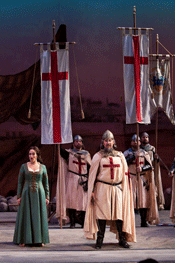 Giselda (Abla Lynn Hamza) and Arvino (Mathew Edwardsen) square off.
Giselda (Abla Lynn Hamza) and Arvino (Mathew Edwardsen) square off.
Sarasota’s 52nd season serves up standards in Boheme and
Giovanni. The company’s Verdi cycle, now on its 27th work,
resumes with I Lombardi. This season Sarasota Opera begins another
venture, the America Classics Series, showcasing the 20th century operas of
American composers. Robert Ward’s The Crucible starts the
series. Skipping across the operatic landscape as it does — from
Puccini’s Paris, Mozart’s Spain, Verdi’s Middle East, and
17th Century Massachusetts — Sarasota Opera’s word for the season
is idiomatic.
It is not enough to note that all shows presented at Sarasota Opera are produced especially for the company, as sets are so perfectly suited to the venue and to the company’s goal of traditional opera readings as to draw raves. Each of the sets for the Festival run is remarkable for the acute use of angles, perspective and for craftsmanship. For Boheme, seen on March 11, the thought David P. Gordon (Scenic Design) gives to matters of stage action was in full effect. At Momus, we see sets at their most practical, to the extent that chorus members occupy a shop within the space allowing free room for the show at the town square (think Harry Potter’s Diagon Alley). Gordon and R.A. Reed Productions crafted this brilliant architectural art that debuted here in 2006.
Maestro Victor DeRenzi’s Puccini is quite grand. Just when the orchestral bounds slid close to a volume bordering on coarse, bearing in mind the space and style, the playing eased back to Puccini. DeRenzi knows this orchestra and vice-versa; he can afford to take risks. On the flip side, the orchestra overpowered singers, as it did Harold Meers (Rodolfo) in “Che gelida manina” and Carelle Flores (Musetta) in her waltz. Singers also found themselves falling behind the music, as did Meers in pickups for the same.
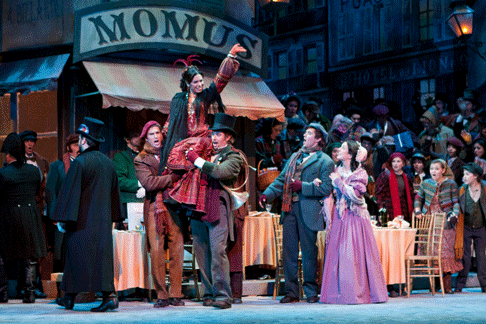 On parade, Marcello (Grante Clarke), Musetta (Carelle Flores), Schnaurd (Matthew Hanscom), Rodolfo (Harold Meers) and Mimi (Maria D'Amato)
On parade, Marcello (Grante Clarke), Musetta (Carelle Flores), Schnaurd (Matthew Hanscom), Rodolfo (Harold Meers) and Mimi (Maria D'Amato)
Meers sang most convincingly when portraying a man powerless over a malady that will take his love in Act III. His sound — tight and lean above the staff — made for a less than affecting connection with that of the Mimi in this performance. Maria D’Amato’s lyric soprano is well-produced on low and carries buttery overtones. Dramatically and vocally, Flores and Grant Clarke (Marcello) were the more interesting pairing in a strong cast of singing-actors. Batting eyelashes and strutting right to the edge of the stage on her entrance was Flores as Musetta. No stranger to Sarasota audiences, Young Bok-Kim’ s dark, round voice had hints of graininess that imparted mettle to his Colline. Sarasota Opera Studio Artists Matthew Hansom and Carlos Monzon were playful as Schaunard and Alcindoro. Benjamin Gelfand’s elegant singing is not what one expects to hear in the role of Benoit and Adam Bielamowicz stopped the show as Parpignol.
Stage director Stephanie Sundine’s influence will be remembered for the well-executed utensil fencing in the opening act and a streaming parade in front of the café. There were tempo kinks between the pit and the men in Act III, otherwise the chorus was musically exacting and energetic. Roger L. Bingaman is Chorus Master and Micheal Shane Wittenburg the Youth Opera Chorus Master.
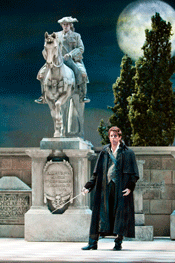 The Commendatore (Benjamin Gelfand) stands on guard over Giovanni (Lee Poulis).
The Commendatore (Benjamin Gelfand) stands on guard over Giovanni (Lee Poulis).
On the streets and in the colonnades of Spain, David P. Gordon’s work (this time constructed by Center Line Studios, Inc.) excels further. Seamlessly fitting pieces and interlocking scenes of fresh squares with walkways either dropped down, slid across, rose up or a combination of these smoothly. Giovanni’s denouement — at some very swank digs — has him going down in damned deglutition at the top of a staircase as hell-fire shades (Lighting supplied by Ken Yunker) gobble him up. In the end, Howard Tsvi Kaplan has Giovanni sporting a Hugh Heffner robe: Giovanni as the feinschmeker he was. Peter Kozma provided a staging sequence that stood out to open Act II, the lights flashed on to Giovanni gaining on Leporello, both in full trot. Jim Hoskins’ choreography was carried out rather sluggishly by Lee Poulis (Giovanni) and Benjamin Gelfand (Commendatore) at this matinee on March 12th.
“If I am true to one, I will be cruel to all others.” While Lee Poulis spoke Da Ponte’s words for Giovanni, there were only faints signs of the attitude that makes such a rake. Poulis fit into Giovanni in other important ways; he is tall, slim and handsome. Gelfand played the officer well, and he was stiff as granite mounted on a steed in the cemetery.
Such are Leporello’s text and music that only a little extra something will have the role come off entertainingly. Playing the straight man might not be Andrew Gangestad’s strongpoint but he was just mordant enough to underscore the ridiculous situation he finds himself in. In the “Catalogue Aria,” Gangestad displayed both admiration for and confusion over his master’s conquests. Sarasota Opera debutant Christina Pier was the Donna Anna. Hers is a voice of ample volume for large houses; in Sarasota’s venue, the sound was piercing to the point of losing some of its luster. Her affianced Ottavio was played by Joshua Kohl. Unpolished, and tried as it was by Mozart’s tricky lines with scales tagged on, the young tenor’s timbre is what makes one take notice. The Donna Elvira Danielle Walker, had little trouble communicating her anger over Giovanni’s interminable infidelity. Studio Artists Patrick McNally (Masetto) and Sarah Asmar (Zerlina) played their parts’ vulnerabilities well. The chorus was tighter across the board for Mozart.
The orchestra played civilly and subdued for conductor and Sarasota Opera regular Anthony Barrese — there was not much here to disturb what exists neither to reveal anything interesting in Mozart’s score.
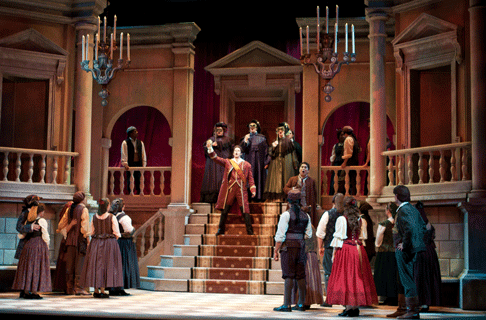 A toast to the Don (Lee Poulis at
center; Andrew Gangestad to the right).
A toast to the Don (Lee Poulis at
center; Andrew Gangestad to the right).
Revealing though is what I Lombardi is in examining Giuseppe Verdi’s career topography. Occupying the period termed Early Verdi, Lombardi marks the beginning of the composer’s life-long struggle with censorship, he officially takes up the mantle of patriot, and in setting a complex cause to music-drama, he takes set pieces to a new level (for one thing, the final two acts are split into six scenes).
As one would expect in a work such as Lombardi performed in Sarasota, the chorus had clearly gone through extensive preparation for this performance (on March 12th). Bingaman’s group sounded more like a well-balanced legion of 80 than the 20 or so there were. The chorus managed to come in and out of the panorama smoothly, as required. The orchestral performance was solid with DeRenzi conducting — the few interludes were warmly shaped, as was Concert Master Liang-Ping How’s violin solo.
Lombari’s character of central interest is more or less Pagano — after being excommunicated and committing patricide, he is received back in the end as a sort of prodigal son. Kevin Short’s imposing baritone gave Pagano intensity and he is an artist with obvious stage sense. As Arvino, Pagano’s brother, Mathew Edwardson’s slender tone cut through the orchestra, his acting was also quite good. Arvino’s daughter Giselda holds much of the opera’s attention through the end of Part One and all of Part Two. Alba Lynn Hanza is a slight woman with a lyric voice that filled the auditorium with Giselda’s urgent pleas of deliverance and objections to war.
In Part Two, Studio Artist Jeffrey Beruan lent a hearty bass to Acciano, the ruler of Antioch. Acciano’s son Oronte is perhaps the best known of Lombardi’s characters, and his “La mia letizia infondere” its best known tune. Shortly after his entrance, Rafael Davila established himself as a singer with little inhibition and some old-school sentimentality. Marvelous stuff. Later, Davila capped Oronte’s “In cielo benedetto” with a tenore di forza-defying diminuendo. For this scene, Yunker and Martha Collins (Stage Director) are applauded for placing the fallen Oronte beyond a dreamy underwater moonlight effect.
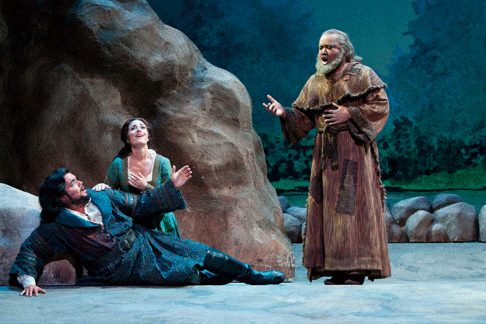 The wandering hermit (Kevin Short) finds Giselda (Abla Lynn Hamza) and the mortally wounded Oronte (Rafael Davila)
The wandering hermit (Kevin Short) finds Giselda (Abla Lynn Hamza) and the mortally wounded Oronte (Rafael Davila)
The lengthy supporting cast for Lombardi all played a part in making this disorganized story, a bear though it is, somewhat engaging.
With Robert Ward’s The Crucible, engagement is never a problem. In reading through Sarasota Opera’s literature reporting on the opera, the word powerful appears many times. From a distance, this work tells the story of the Salem witch trials. Up close, Arthur Miller’s play The Crucible — from which Ward created his opera — is a specific account of human treachery that recycles through time, therefore regenerating as a topic of concern and interest.
Micheal Unger’s stage direction was instrumental in the power of this performance of Crucible (March 13 matinee). The positioning, and jumpiness, of male characters at Reverend Parris’ house was tension-inducing. The distance kept between the Proctors at the farmhouse kitchen was indicative of the couple’s split and how their individual misunderstandings led to mutual isolation. The Act II courtroom was one of a sniveling and jeering cabal out to bring down the Proctors and whip up Abigail Williams on one side, and the outnumbered and drowned-out voice of reason (Reverend John Hale, for one) on the other.
Ward’s use of driving, tense strings and the presence of horns relaxes as the story unfolds and some of the scoring turns reminiscent of Korngold’s film music. He keeps the vocal line moving, with few inklings of extended melody and many exposed notes right in the break of the voice. Conductor David Neely and orchestra represented Ward very well overall.
A hulking and strapping man whose baritone has similar qualities, Sarasota Opera returnee Sean Anderson made a commanding impact as John Proctor. By the time of Proctor’s booming high note of despair closing Act II, the stage was set for a bring-down-the-house performance. Anderson’s acting at the jail was gut-wrenching in its pathos (this was enhanced by skillful disheveling of Anderson by Wig and Make-up Designer Georgianna Eberhard).
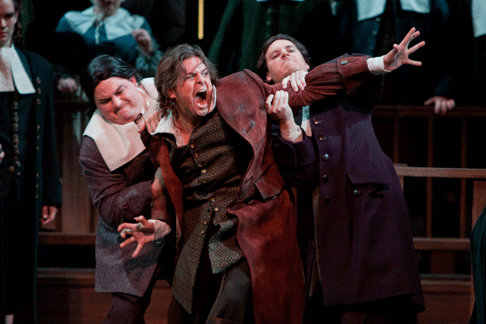 Enraged, John Proctor (Sean Anderson, middle) is restrained in the
courtroom (Thomas Putnam, played by Dimitrie Lazich at right).
Enraged, John Proctor (Sean Anderson, middle) is restrained in the
courtroom (Thomas Putnam, played by Dimitrie Lazich at right).
Heather Johnson ably produced both the strong and broken sides of wife Elizabeth Proctor. The role of Reverend John Hale is the sunniest in terms of Crucible’s social commentary and Jeffrey Tucker communicated this well. Studio Artists Steven Uliana (Reverend Samuel Parris) and Dimitrie Lazich (Thomas Putnam) were excellent. Tenor Uliana handled Ward’s demanding vocals and Lazich adroitly steered his baritone through Putnam’s high tessitura and declamations. The entire cast of over 20 in Crucible could have been a touring company performing this one piece alone, such was the synchronicity of the production.
What was mentioned of Sarasota Opera’s sets applies to the work of Michael Schweikardt, and the company for building the sets, for Crucible. The wood in Act III is particularly memorable for its plain treatment; lined patterns of slim, straight-trunked trees with small leaves were softly lit (by Yunker) suggesting the coming dawn.
Sarasota Opera’s Winter Festival closes on March 20th, alive and in idiomatic style.
Robert Carreras
Cast Lists
La boheme (Friday, March 11)
Conductor: Victor DeRenzi. Stage Director: Stephanie Sundine. Scenic Designer: David P. Gordon. Costume Coordinator: Howard Tsvi Kaplan. Lighting Designer: Ken Yunker. Wigs & Make-Up Designer: Georgianna Eberhard. Chorus Master: Roger L. Bingaman. Youth Opera Chorus Master: Michael Wittenburg.
Mimi: Maria D’Amato; Rodolfo: Harold Meers; Marcello: Grant Clarke; Colline: Young-Bok Kim; Benoît: Benjamin Gelfand; Musetta: Carelle Flores; Schaunard: Matthew Hanscom; Alcindoro: Carlos Monzón.
Don Giovanni (Saturday, March 12 matinee)
Conductor: Anthony Barrese. Stage Director: Peter Kozma. Scenic Designer: David P. Gordon. Costume Designer: Howard Tsvi Kaplan. Lighting Designer: Ken Yunker. Wigs & Make-Up Designer: Georgianna Eberhard. Chorus Master: Roger L. Bingaman.
Donna Anna: Christina Pier; Donna Elvira: Danielle Walker; Don Ottavio: Joshua Kohl; Don Giovanni: Lee Poulis; Leporello: Andrew Gangestad; The Commendatore: Benjamin Gelfand; Zerlina: Sarah Asmar; Masetto: Patrick McNally.
I lombardi (Saturday, March 12)
Conductor: Victor DeRenzi. Stage Director: Martha Collins. Scenic Designer: Jeffrey W. Dean. Costume Designer: Howard Tsvi Kaplan. Lighting Designer: Ken Yunker. Wig & Make-Up Designer: Georgianna Eberhard. Chorus Master: Roger L. Bingaman.
Giselda: Abla Lynn Hamza; Oronte: Rafael Dávila; Arvino: Mathew Edwardsen; Pagano: Kevin Short; Pirro: Benjamin Gelfand; Viclinda: Lindsay Ohse; Sofia: Sarah Larsen; Prior of the City of Milan: Heath Huberg; Acciano: Jeffrey Beruan.
The Crucible (Sunday, March 13 matinee)
Conductor: David Neely. Stage Director: Michael Unger. Scenic Designer: Michael Schweikardt. Costume Designer: Howard Tsvi Kaplan. Lighting Designer: Ken Yunker. Wigs & Make-Up Designer: Georgianna Eberhard. Chorus Master: Roger L. Bingaman.
Elizabeth Proctor: Heather Johnson; Judge Danforth: Mathew Edwardsen; John Proctor: Sean Anderson; Reverend John Hale: Jeffrey Tucker; Abigail Williams: Lindsay Barche; Mary Warren: Lara Michole Tillotson; Ann Putnam: Lindsay Ohse; Tituba: Nicole Mitchell; Ezekial Cheever: Bernard D. Holcomb; Thomas Putnam: Dimitrie Lazich; Francis Nurse: Bradley Smoak.
image=http://www.operatoday.com/CrucibleGallows.gif image_description=Crucible's verdict. John Proctor (Sean Anderson) and Rebecca Nurse(Kaitlin Bertenshaw) on the gallows. [Photo by Rod Millington courtesy of Sarasota Opera] product=yes product_title=Sarasota Opera Winter Festival 2011 product_by=See cast lists in body of review product_id=Above: Crucible's verdict. John Proctor (Sean Anderson) and Rebecca Nurse(Kaitlin Bertenshaw) on the gallows.All photos by Rod Millington courtesy of Sarasota Opera
March 23, 2011
The Turn of the Screw at LA Opera
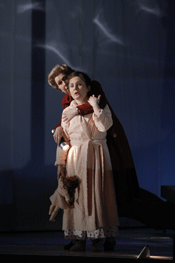 Ann Murray as Mrs. Grose and Ashley Emerson as Flora
Ann Murray as Mrs. Grose and Ashley Emerson as Flora
As seen on March 17th, Los Angeles Opera’s second performance of Benjamin Britten and Myfanwy Piper’s The Turn of the Screw (adapted from Henry James's short novel), with Patricia Racette, Ann Murray and William Burden in the lead roles and James Conlon in the pit, turned out to be less than the sum of its parts. The easy answer as to why would be to note the work’s origin as a chamber piece, more suited to a hall much more intimate than the 3000+ seat Dorothy Chandler Pavilion. But that would fail to give credit to the admirable job Conlon did in producing a full but not grandiose sound from his small group of musicians, and it would also mean slighting the brilliant design work of Paul Brown. Brown’s sets, created for Glyndebourne Festival Opera, bring in the sides of the proscenium, with a deeper stage perspective and a wonderfully silky and quiet turntable easily bring action from the rear to the front, allowing voices to always project out.
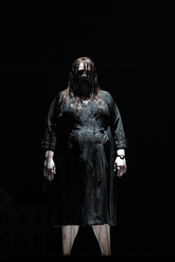 Tamara Wilson as Miss Jessel
Tamara Wilson as Miss Jessel
The set also manages to be sparse in its design elements and then flexible enough to rearrange the key features to effortlessly change scenes. A huge glass-latticed wall hangs suspended, twisting, rising and lowering as needed to close off and open up the action. Two huge bare tree trunks, twisted with dead branches, also drift down and up to evoke both the literal outdoors and the spooky “otherworld” of the ghosts. Director Francesca Gilpin gets an astonishingly poised performance from young Michael Kepler Meo as Miles, but the director deserves praise as well — to be shared with the performer, of course — for matching young Miles with the adult Ashley Emerson, almost eerily believable as Miles’s young sister. Meo has performed this role elsewhere; obviously he will outgrow it at some point, but the talent he displays gives promise of a very interesting career ahead. Emerson looks to be at the start of such a career.
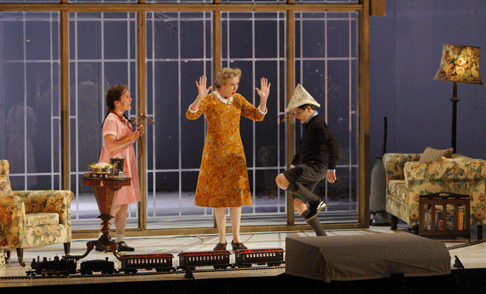 Ashley Emerson as Flora, Ann Murray as Mrs. Grose and Michael Kepler Meo as Miles
Ashley Emerson as Flora, Ann Murray as Mrs. Grose and Michael Kepler Meo as Miles
The more mature adults in the cast live up to the promise of their well-known names. Patricia Racette may be simply too healthy to elicit any fearful sympathy on the part of the audience for her Governess faced with troublesome wards and ghostly emanations. Her singing, however, found her in fine voice — secure in intonation and able to modulate her volume appropriately to the setting. The one key fault, and one not unknown for sopranos, was her inability to always project comprehensibly the English text. When tenor William Burden sang, for example, there was never any need to glance up at the super-titles. Burden also proved himself an extremely fine actor — briefly appearing in the prologue as an unidentified but apparently “normal’ man relating the story as handed down through the Governess’s writings, and then dominating the evening as the progressively creepier ghost of the manor’s groundskeeper, Peter Quint. Britten wrote some fairly athletic music for Quint, and Burden proved himself more than up to the eerie runs.
As Peter Quint’s ghostly companion Miss Jessel, Tamara Wilson brought a solid but attractive soprano, one surely capable of many more challenging roles. A fairly large woman, Ms. Wilson was dressed by the designers in black and had wet hair lying flat, so that she should looked a bit like a plus-size version of the ghost in the movie The Ring. Miss Wilson proved herself a very brave performer at one point — lying down flat as the suspended glass lattice slowly descended upon her, stopping just short of crushing her — if a ghost can be crushed…
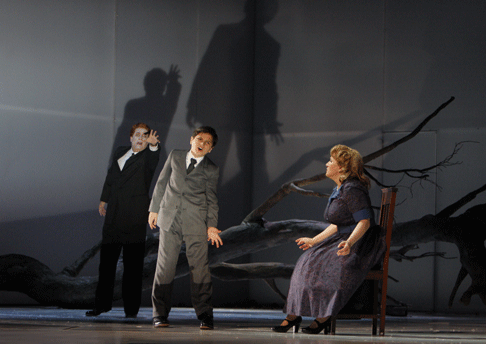 William Burden as Peter Quint, Michael Kepler Meo as Miles and Patricia Racette as the Governess
William Burden as Peter Quint, Michael Kepler Meo as Miles and Patricia Racette as the Governess
Racette’s Governess interacts mostly with Mrs. Grove, sung by Ann Murray. Miss Murray has retained, at this point in her long career, a good amount of voice and a strong stage presence. Somehow, however, these scenes were the most problematic of the evening. Neither woman could sing her lines with consistent comprehensibility nor convey the growing apprehension and fear key to the success of a more psychologically-oriented story such as this.
In other words, this was not a very scary The Turn of the Screw — and without being scary, the material can come awfully close to being pointless, if not silly. Nonetheless, the opportunity to hear Britten’s intelligent, evocative score performed by excellent musicians and singers shouldn’t be overlooked. A less than full house gave all the performers a warm ovation, but the inevitable standing ovation was quite slow in developing, and in the end, it included a fair number of people rising to make their way to the exit. With Britten’s Albert Herring programmed for the next season, Los Angeles Opera might do well to consider what sort of publicity will help fill the Dorothy Chandler for those performances — or finding another venue more appropriate to the scale of that piece as well.
Chris Mullins
image=http://www.operatoday.com/tos6283.gif
image_description=Patricia Racette as the Governess
product=yes
product_title=Benjamin Britten: The Turn of the Screw
product_by=The Governess: Patricia Racette; Prologue/Peter Quint: William Burden; Flora: Ashley Emerson; Miles: Michael Kepler Meo; Mrs. Grose: Ann Murray; Miss Jessel: Tamara Wilson. Los Angeles Opera Orchestra. Conductor: James Conlon. Director: Francesca Gilpin. Scenery and Costume designer: Paul Brown.
product_id=Above: Patricia Racette as the Governess
All photos by Robert Millard courtesy of Los Angeles Opera
Tristan und Isolde, Deutsche Oper, Berlin
By Renaud Loranger [Financial Times, 23 March 2011]
Call it the triumph of the anti-heroes. As Tristan exits the stage at the end of Act Three, he has become a disillusioned, grumpy old fool whose dabbling in drugs has only provided momentary marital bliss. He rants about the past while Kurwenal keeps himself to himself, then vanishes into darkness. Isolde, ageing and frail, tends to a coffin before singing a listless “Liebestod”.
Machover, Death and the Powers
But there are also moments of fragile lyricism, pretty melodies that sing of the old values of love and touch. The opera vacillates between the loud future of silicon and solenoid, and the quietly humane past.
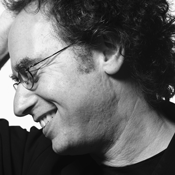 Tod Machover
Tod Machover
Like certain other short operas, such as Rachmaninov’s Francesca da Rimini, this is an opera in the past tense: the prologue shows us robots in a post-organic world, trying to puzzle out the meaning of the nonsensical word death. (There is something too cute about these robots, who look like the sly agile desk lamps in the old Pixar animation, and who sound like the apotheosis of R2D2.) The robots put on a skit—the opera itself—about the transformation of the human into the post-human: a billionaire named Simon Powers decides to abandon his dying body and place his consciousness, his identity, into The System, a motile all-encompassing electrical structure that is slowly replacing a dematerializing world. In this quest he is aided by Nicholas, a young assistant with a prosthetic arm, and resisted, at least partly, by his third wife Evvie and his daughter Miranda.
The name Miranda of course brings to mind Shakespeare’s The Tempest, and makes us wonder whether Powers is just another name for Prospero. In Dryden’s adaptation of The Tempest, Prospero never forswears magic and retains his mastery over the elements; and Simon Powers is a magician who keeps his power, although he may be a wizard lost in his own labyrinth. Nicholas, who dances and prances around the stage, and climbs up the grid of lights, is his affable Ariel.
Robert Pinsky’s text is more clumsy that one would expect from a distinguished poet, full of lame puns and overextended parallels: he keeps hitting you over the head with quotations from Yeats’s “Sailing to Byzantium” (a poem about an old man who muses on his possible transfiguration into a mechanical bird) and with plugs for poetry itself as something Important to the Human Soul. But the text does have the virtue of a certain moral ambiguity: it would have been easy to deplore the robots and to uphold the grand old human world of tears and joy; but Pinsky refuses this easy simple conflict, and makes The System a seductive place with at least partially real delights, and makes the human world a place of evil as well as good. At one point the delegates from the United Way, the United Nations, and the United States (the last a superb bass, Tom McNichols, maybe the best singer in the cast) visit the virtualized Simon to plead with him not to ruin the global economy. But these are not figures of pathos, but officious fools, somewhat like the Jews in Strauss’s Salome. And when the starving multitudes thrust themselves onto the stage toward the end of the opera, they seem like a bloodthirsty mob about to tear Miranda limb from limb. Only Miranda and Evvie place the warm world of sorrow and devotion in a favorable light; and Evvie, at least, herself decides to enter The System. In his interesting program note, Pinsky implicitly compares his text to “a robot that performs the work of meaning and emotion…the robots [in the opera] are in a sense returning the favor of creation”; and intelligence and sensitivity of robots constitute an important theme here.
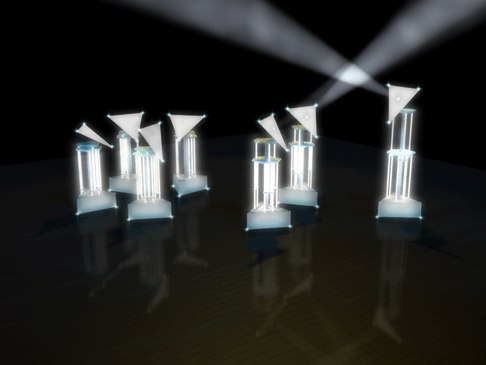 Rendering of Operabots interacting with each other
Rendering of Operabots interacting with each other
It is an odd opera in that there is little romantic love, and little conflict beyond the cerebral pondering of robot vs. human cerebration. In this way it resembles Das Rheingold, another opera with little romantic love, and a good deal of thinking about the values of the wet old healthy elemental world vs. the values of a futuristic society built by robots (or, as Wagner called them, giants). In the scene where Simon gloats over his successful assimilation into The System, Machover bases the music on a triumphalist Naturthema not out of place in Wagner; and the sustained roar of certain episodes near the end might call to mind another great moment of sensory overload, the final bars of Das Rheingold.
The singing was satisfactory and evidently accurate, but unremarkable. James Maddalena, the Simon, was not in excellent voice, but his forceful baritone made for a potent stage presence—Alberich the billionaire, invisible in his Tarnhelm but dominating the world.
Daniel Albright
image=http://www.operatoday.com/Machover_miranda_sara.gif image_description=Sara Heaton as Miranda [Photo: http://opera.media.mit.edu/projects/deathandthepowers/gallery.php] product=yes product_title=Tod Machover: Death and the Powers product_by=Simon Powers: James Maddalena; Evvy: Emily Albrink, Patricia Risley (Monaco Premiere); Miranda: Sara Heaton, Joélle Harvey (Monaco Premiere); Nicholas: Hal Cazalet. The United Way: Doug Dodson, Frank Kelley (Monaco Premiere); The United Nations: David Kravitz; The Administration: Tom McNichols, Daniel Cole (September 2009 Workshop). Boston Modern Orchestra Project. Conductor: Gil Rose. Principal Keyboard: John McDonald. Second Keyboard: Linda Osborn-Blaschke, Simone Ovsey (September 2009 Workshop). Director: Diane Paulus. Production Designer: Alex Mcdowell. Choreographer: Karole Armitage. MIT Media Lab. product_id=Above: Sara Heaton as Miranda [Click here for photo gallery.]Philip Glass’s Orphée
At first, as they replaced the wonderful world of 12-inch vinyl records and their sleeve art, CDs offered only cheap plastic cases, prone to breaking, with the art on the cover slips and booklets offering at its best some visual interest but in sadly reduced proportions. As time went on after the CD format’s debut, some companies learned how to create the CD case in other materials, with sleeves for booklets and textural appeal. But with the shrinking of the market, things seem to have devolved back to a rudimentary state — why put money into the packaging, when the market now is to sell as many copies at as low a price point as possible?
The above paragraph comes by way of saying that for your reviewer, the most impressive thing about the CD release of a 2009 Portland Opera performance of Philip Glass’s Orphée is the deluxe packaging. Brown-tinted photographs of the cast and sets are found on every face of the case, which opens up into a “four-fold” configuration. Inside there is a separate sleeve at each end, containing a booklet for each act, with libretto. The discs themselves match the color scheme of the packaging’s graphics, and for once they are easily removed and restored to their secure holding mechanism. Orange Mountain Music — which is, after all, the composer’s own label — has certainly created a beautiful keepsake for anyone who saw the performances and wants a permanent souvenir, as well as a lovely set for the composer’s many admirers — of whom, your reviewer cannot be counted.
Glass has adapted Jean Cocteau’s screenplay for that much greater artist’s updated film adaptation of the story of Orpheus and Eurydice. The production seen in Portland, as conveyed by the set’s many photographs, sets the scene in an upscale home, vaguely mid-20th century in appearance but with a late 20th century ironic twist to every spare detail. The libretto plays intriguing games with the well-known story, introducing other characters and settings to offer a prism-like view of the essential elements of reconciliation with death. The opera is not long — barely 100 minutes — but the tone of hip self-satisfaction with its own cleverness grows wearisome quickly.
As anyone with a passing familiarity with Glass’s music might expect, the score comes in sections, with a tempo and mood established initially that rarely varies much within a section, with any sense of development or variety coming from slight variations on the basic musical material or orchestration. One section ends, there’s a pause, and another section begins, until the last section is reached, and the whole thing slips into silence. Glass can come up with a catchy figure here and there, no doubt. With the libretto in French, some moments recall the languid mood found is some parts of Debussy’s Pelléas et Mélisande. The comparison does not flatter Mr. Glass.
Conductor Anne Manson must be a fan of the composer, however, because she does very well by the score. In the hands of anyone less in tune with Glass’s musical world, the music can come across as so relentlessly banal it can provoke anger. Here, it’s all rather pleasant, though insubstantial and unmemorable. In the title role, Philip Cutlip sings with curiously flat emotional tone but welcome agility. Lisa Saffer in the key role of The Princess sounds a bit stressed sometimes by some high tessitura, but her middle voice is quite attractive. The rest of the cast matches their professionalism.
A DVD might be a more appropriate document for this opera, as the soundtrack alone may not convey the score’s possible intent of making ironic contrast to the action. As a listening experience, it will make for some gentle earwash as one admires the beauty of the set’s packaging.
Chris Mullins
image=http://www.operatoday.com/Glass_orphee.gif
image_description=Philip Glass: Orphée
product=yes
product_title=Philip Glass: Orphée
product_by=Orphée: Philip Cutlip; La Princesse: Lisa Saffer; Heurtebise: Ryan MacPherson; Eurydice: Georgia Jarman. The Portland Opera Orchestra. Conductor: Anne Manson.
product_id=Orange Mountain Music 0068 [2CDs]
price=$24.99
product_url=http://www.arkivmusic.com/classical/Drilldown?name_id1=4476&name_role1=1&bcorder=1&comp_id=374613
March 18, 2011
Bellini’s I Puritani in Bologna
Purity, while an esteemed virtue, can nonetheless pose challenges to the impure majority, whether in the world as a whole or in that tiny domain inhabited my opera lovers.
Few in that world would deny that Bellini’s scores boast musical episodes as beautiful as any other music by any other operatic composer. However, only one of the composer’s works has truly attained standard repertoire status: Norma, with its incomparable score written to a tight, evocative libretto — which is a rarity for Bellini. His other operas tend to spin gold out of cornpone (La Sonnambula) or outdated romantic hogswoggle (Il Pirata). In the case of I Puritani, Bellini selected one Carlo Pepoli to craft the libretto, although the poet had no libretto experience.
The resulting work, set in the Cromwellian revolt against Catholic Charles I, has a passable first act that sets up a love triangle, the first side of which is represented by Sir Riccardo Forth, who suffers from an unrequited passion for Elvira. She is in love with Lord Arturo Talbo — a love that is very much requited. But when brave and honorable Arturo flees on his wedding day in order to save the widow of Charles I from his Puritan compatriots, without telling anyone, Elvira goes mad. Act two consists of little more than Elvira losing her mind, and then act three restores her sanity with Arturo’s return (with explanation). The triangle has become a footnote by then.
For a production new in 2009, director Pier’Alli apparently trusts the music’s ability to override the weak libretto. Different viewers may find his trust repaid or misplaced, to varying degrees. The stage is all but bare, with tall walls in back, the openings between which reveal a blue background. In act one those openings contain gigantic swords, standing as if thrust into the ground. Since militarism is just a context for the true story of frustrated and then recovered love, this comes across as just a design affect. The only true creativity comes in the director’s costumes, which are traditional and handsomely detailed. Beyond that, evidence of the director’s hand can’t be easily found. The large chorus tends to move into place and stick there. The lead singers march to the center of the stage, find their mark, and sing. Perhaps the director deserves some credit for Nino Machiadze’s subtlety. As Elvira, the soprano doesn’t do any eye-rolling or stage-lolling. She lets her unalloyed love for Arturo shine out of her eyes in act one, and then she lets the life drain out of her visage as she loses her metal equilibrium in the last two acts. The soprano’s voice has a tartness that also helps undercut the role’s tendency to one-dimensionality. At this relatively early stage in her burgeoning career, a performance such as this shows that Ms. Machiadze will focus on her craft rather than on the allure of histrionics.
And that’s a quality that the Arturo, Juan-Diego Florez, has demonstrated since his career’s inception. Although some may prefer a juicier voice in this role, Florez has the secure high notes and agility that the music requires, and he looks quite good. Unfortunately, beyond these two talented leads, the cast declines in appeal. The opening scene goes to a minor character sung by one Gianluca Floris, who has a most unappealing character tenor. Ildebrando D’Arcangelo brings a stolid bass sound to the stolid role of Elvira’s uncle, and Gabriele Viviani is less than vivid as the ostensible alternate love interest, Sir Riccardo.
When Machiadze and Florez are on stage, whether separately or together, this I Puritani works very well, allowing for the inherent weakness of the story and its characterization. The true worth of the opera is in its music, and they both represent that very well. But given the paucity of Pier’Alli’s design concept and stage direction, and the less than glamorous supporting cast, this can’t be called a model I Puritani. Nonetheless, there’s not a lot of competition when it comes to this title. The picture and audio quality can’t be faulted, and the Bologna forces play very well for young conductor Michele Mariotti. If a static and handsome production can be accepted, and if one’s focus is primarily on the two leads in this opera, the Bologna I Puritani fits the bill.
Chris Mullins
image=http://www.operatoday.com/Decca0743351.png
image_description=Vincenzo Bellini: I Puritani
product=yes
product_title=Vincenzo Bellini: I Puritani
product_by=Elvira: Nino Machaidze; Lord Arturo: Juan Diego Flórez; Sir Riccardo: Ildebrando D’Arcangelo. Orchestra e coro del Teatro di Bologna
Conductor: Michele Mariotti.
product_id=Decca 000440 074 3351 5 [2DVDs]
price=$26.99
product_url=http://www.arkivmusic.com/classical/Drilldown?name_id1=888&name_role1=1&comp_id=10999&genre=33&label_id=2303&bcorder=1956&name_id=158280&name_role=3
Roméo et Juliette, New York
With its faux marquetry sets by Johannes Leiacker and spectacular astronomical projections for the star-crossed and velvet-clad lovers (lighting by David Cunningham, costumes by Jorge Jara), the stage is always a delight to watch while this is on, no matter who is singing. I wish they’d use these sets for operas I liked better—Donizetti’s Lucrezia Borgia, say, or Bellini’s I Capuletti ed i Montecchi (to keep the story on track), or Verdi’s Trovatore or Vespri, or Auber’s La Muette de Portici, or Mercadante’s Il Bravo, or Mascagni’s Parisina, or Schreker’s Die Gezeichneten, or Korngold’s Violanta—just about anything Renaissance-themed and at least faintly Italian. It’s entirely too beautiful to leave it to rare encounters with sugary Gounod.
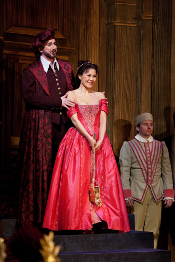 Dwayne Croft as Capulet and Hei-Kyung Hong as Juliette
Dwayne Croft as Capulet and Hei-Kyung Hong as Juliette
The current revival was to have placed gallant young Polish tenor Piotr
Beczala beside Romanian glamour-girl soprano Angela Gheorghiu, but for whatever
reason (illness, she says) Madame Gheorghiu was a no-show. I do not
find the lady’s voice or her use of it persuasive enough to mourn her
absence. Standing in for her was Hei-Kyung Hong, who with all the looks, twice
the technique and three times the vocal gift of Gheorghiu, has never been a
candidate for stardom but, rather, a totally assured first-class house singer
of roles from Handel, Mozart and Verdi to Puccini and Wagner. If she has lacked
the spark of individuality that inspires cult, her dedication to
singing, to excellence, has made her a favorite with Met audiences for
twenty-five years. She is still a pretty woman and an able actress, albeit
lacking the little self-knowing and personal touches that a stage animal like
Natalie Dessay brought to Juliette when this production was new. Too, she might
be faulted for a certain coolness, a lack of passion—this Juliette does
not grow into a woman convincingly, but that is partly due to the omission at
the Met of her potion aria in Act IV. In any case, after a few nervous high
notes in the coloratura showcases of Act I, Hong settled into a lovely,
creamily sung performance.
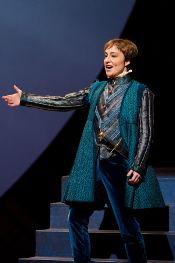 Julie Boulianne as Stephano
Julie Boulianne as Stephano
Beczala, a tenor I have admired as Edgardo and Lenski, has the Slavic fault
(I identify it with Hvorostovsky) of pausing between beautiful phrases that
should be strung together in ardent, breathless apostrophe, but his
“Lève-toi, soleil” was nonetheless a high point of a year of good
tenorismo. He was ably supported by Sean Panikkar’s Tybalt; Lucas
Meacham’s impressive Mercutio; James Morris’s rumbly Frère Laurent;
and Dwayne Croft’s most distinguished Capulet. Mr. Croft is another of
those house singers who brings class to anything he sings, and he seemed very
much the host of this gala party. Wendy White was not up to her usual standard
as the Nurse—I could hardly hear he in the wedding quartet, and I was
sitting thirty feet away. Julie Boulianne, a mezzo with a developing
reputation, sang Stephano: She puzzled me, as she has in the past, not for the
occasional ringing and beautiful high notes, which are sure to please, but for
the off-pitch or scattershot phrases that led up to them. The conductor was
Plácido Domingo, and though his beat seemed draggy at times, he kept things
trundling and never threw the singers for a loop, no doubt remembering
occasions when he had to keep his eye on a vague baton.
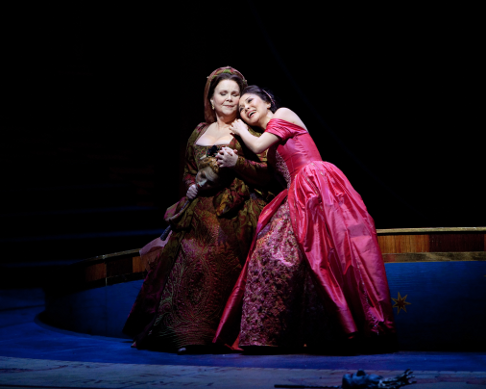
The crowd-movements were passable but the dueling was not. I would not say this if I had not seen the street brawl and the deaths of Mercutio and Tybalt done so very well in the old Met production of this opera, some of the most realistic swordwork by elegant young men in tights I’ve ever seen on any stage. The current version, which relies too much on knife lunges (that must fall on the right crescendo to be effective), is unnecessarily awkward and complex. The singers tried, but they could not make it seem natural. The Met should try to find the guy who set this scene up in 1996 and entreat him to do it again.
John Yohalem
image=http://www.operatoday.com/RJ_Met_2011_01.png image_description=Piotr Beczala as Roméo and Hei-Kyung Hong as Juliette [Photo by Marty Sohl courtesy of Metropolitan Opera] product=yes product_title=Charles Gounod: Roméo et Juliette product_by=Juliette: Hei-Kyung Hong; Stephano: Julie Boulianne; Roméo: Piotr Beczala; Tybalt: Sean Panikkar; Capulet: Dwayne Croft; Mercutio: Lucas Meacham; Frère Laurent: James Morris. Chorus and Orchestra of the Metropolitan Opera, conducted by Plácido Domingo. Performance of March 14. product_id=Above: Piotr Beczala as Roméo and Hei-Kyung Hong as JulietteAll photos by Marty Sohl courtesy of Metropolitan Opera
March 16, 2011
Magnificent Mahler by Shanghai Symphony
The bird calls of the First Symphony were unhackneyed, and those who recalled Mahler’s early programmatic references in the work to the awakening of spring — to fruits and flowers — found themselves in a magic garden for a program that combined the Wayfarer Songs and the four-movement version of the First Symphony. Even had it been performed in a Midwestern blizzard, however, this was Mahler that made one sit up and listen — and be grateful for a moving musical experience.
The Shanghai Symphony, which dates back to a municipal band in the 1870s, is today the outstanding orchestra of Eastern Asia. Under Music Director Long Yu it has toured Europe and the US and has even been heard at the movies on the sound track of Crouching Tiger, Hidden Dragon. Although it must be said that the SSO does not have the refined and mellow sound of many Western ensembles — the silvered strings and burnished brass, it has something of greater importance: the dedication of its instrumentalists and their full emotional involvement in what they are doing.
Guest conductor for Mahler was Chinese-born Lan Shui, currently music director of the Singapore Symphony and — since 1907 — chief conductor of the Copenhagen Philharmonic. Given the conductor’s adolescent mien, it is difficult to believe him old enough to have once been tutored by Leonard Bernstein at Tanglewood. In the States he has held positions with orchestras in Detroit, Cleveland, Baltimore and Los Angeles.
Lan Shui is elegant and unmannered and he knows his Mahler as if by instinct. His reading of the First Symphony was analytic, but never academic. He sensed in the score a narrative impulse, but knew how wrong it would be to make that into a romp through field and forest. And outstanding was his “feel” for the irony that gives the First that “there’s-more-here-than-meets-the-ear” sensation. He deliciously caught the tongue-in-cheekedness of the hoarse bass that leads to “Brother Martin” in the third movement, thus making clear that this is funereal music of quite a different color from that heard in the Fifth Symphony.
For even the still-youthful First can grow lugubrious in the hands of a conductor with no understanding of the many levels of the score. Thus it was no surprise when Lan Shui brought the horn section — bells up-turned — to its feet in the brass blast that concludes the First. This was exuberant Mahler.
China’s Yang Jie is a true alto with a radiant and resonant low register well suited to the Wayfarer Songs, on which Mahler worked in the years of the First Symphony. In the West she includes Carmen in her signature roles. Long gone is the day when Wayfarer with its story of unrequited love was consider male property — just as the outwardly maternal Kindertotenlieder were once assigned to female vocalists. With perfect German diction Yang Lie is totally at home in the cycle with its shifting moods, its light and dark moments.
The quality of the March Mahler was undoubtedly enhanced by the presence in the orchestra of all four members of the Shanghai String Quartet. Founded in the city three decades ago and now on the faculty of the local conservatory, the four men enjoy “sacred-cow” status in Shanghai. When in town they teach at the Conservatory from which they graduated. (In the States they are in residence at New Jersey’s Montclair State University.) First violinist Weigang Li served as concert master on March 12.
Although the Shanghai Concert Hall, the orchestra’s local home, was built by a Chinese architect in 1930, it would be at home next door to Vienna’s gilded Musikverein or any of the historic halls of Europe that have survived. The hall — 1200 seats seems a good guess at its size — was reopened in 2004 following total reconstruction. It is acoustically sound, and generous lobbies opened onto balconies on a mild March evening. It is close to downtown, and taxis at a flat rate of 12 Yuan — no tips! — abound.
It would be presumptuous for a first-time concert goer in China to draw sweeping conclusions from a single experience. Nonetheless certain things were happily obvious. The concentrated — indeed, devout — attention that the Chinese bring to music is astonishing. Barely a muscle moves; even breathing seems hushed. There is absolutely no applause between movements, and the standing ovation now near-obligatory in the West is absent in Shanghai. Enthusiastic applause continued until conductor took concert master by the hand and left the stage.
The college-age set is a far larger part of the Shanghai audience than it is in the States — explained in part perhaps by the fact that the city boasts China’s major conservatory. And dress? As in almost all countries today one comes as one is. The “little black dress,” if China ever had one, has gone the way of the Mao jacket!
Wes Blomster
image=http://www.operatoday.com/Shui_Lan.gif image_description=Shui Lan [Photo courtesy of Shanghai Symphony Orchestra] product=yes product_title=Gustav Mahler: Symphony no. 1 in D major (the “Titan”); Lieder eines fahrenden Gesellen (Songs of a Wayfarer) product_by=Shanghai Symphony Orchestra. Shui Lan, conductor. Yang Jie, alto. Shanghai Orchestra Hall, March 12, 2011. product_id=Above: Shui Lan [Photo courtesy of Shanghai Symphony Orchestra]March 15, 2011
Rodelinda, Royal College of Music, London
[Financial Times, 15 March 2011]
It hardly feels two years since the commemorative events marking the 250th anniversary of Handel’s death. Every year seems to be Handel year now: there is hardly any period in the calendar without his music and the newly invigorated London Handel Festival, in its 34th year, has turned the spring into a veritable Handelian open season.
The Queen of Spades, New York
(There are seven in the opera; he’s in every one.) At first, he seems undecided whether he is crazed by poverty, by the contempt of his fellow officers or by his yearning for an unknown beauty, who turns out to be Lisa, a typical Russian girl just waiting for a brute to toss her around to fulfill his obsessions. (“I am your slave; I belong to you”—per Met TitlesTM.)
The confusion in Ghermann’s character is courtesy of the librettist, Modest Tchaikovsky—in Pushkin’s splendid short story, Ghermann doesn’t give a damn about the girl, only about money, and he seduces her only to learn the Countess’s magical secret of winning at cards—a secret that may exist only in his mind. But an opera is not a short story, and Modest knew his brother Pyotr’s penchant for romance and drama: As with Eugene Onegin, also taken from a Pushkin source, irony went out the window in order to let the score’s passion fill the room. Had the composer been truer to Pushkin, his operas would have been far less successful than they are—both artistically and with the public. And The Queen of Spades is a great favorite, if the tenor is mad enough, the soprano wild enough, the Countess sinister enough, the conductor in control of things.
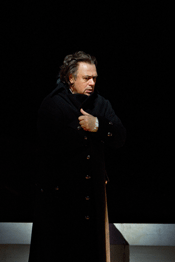 Vladimir Galouzine as Hermann
Vladimir Galouzine as Hermann
Elijah Moshinsky’s 1995 production was devised for the farewell (to
the Met, to the stage, to life as a matter of fact, for she received her cancer
diagnosis during the run) of Leonie Rysanek in the title role—she would
hardly have consented to depart with anything less. The climax of her final
performance was her ghostly appearance in Act III, not from the shadows of
Ghermann’s room but bursting through the floor, backed by the flames of
Hell, creeping in a singed red satin Ancien Regime ball gown (who wore
red at Louis XV’s Versailles?) across the floor and actually
into bed with the gibbering Ghermann of Gegam Gregorian to give him the secret
of the three cards, while he seemed to lose what little remained of his sanity
before our very eyes. This madcap staging would never suit any other lady, and
subsequent Countesses have modified it considerably, though they still enter
through the floor in uncompromising crimson—almost the only color in the
costumes all night long. Elisabeth Soederstrøm (also bidding farewell to the
Met) managed to make this work while just standing there by the bed, rigid,
cold, unwillingly handing the cards to Plácido Domingo, who seemed shocked but
hardly insane.
In the current revival, Dolora Zajick, a no-nonsense lady who shows no sign of needing a stick (she whacks Vladimir Galouzine over the head with it when he pulls a gun on her), seems neither supernatural nor doomed when she climbs through the floor. She might be a neighbor come to complain about the noise. She looks irritated by his bad behavior but hardly vindictive or supernatural. It is the keynote of her entire performance: down to earth, where the Countess should be uncanny even while she’s alive. This is a ghost story without a haunt. When Zajick appears at the very last, to the dying Ghermann, she possesses all the mystery of a concierge come to collect an unpaid dry cleaning bill.
(One of the most tiresome tricks of stage directors bereft of ideas is to show us the ghost, vision, dream, phantasm of a character who is imagining things. Bringing the Countess on stage in the last moments is a symptom of this, though it could be worse—Francesca Zambello brought back Lisa, too, at this moment. And then there’s the ghost Mary Zimmerman provided in Act I of Lucia to distract us from the soprano’s cavatina. Lucia can’t see this—only we do. Why? But you get the idea.)
Zajick is, in any case, too young or just too brash to play the Countess, a role that should be sung with presence, with gesture, with the wisp of faded voice and not the bellow of a woman who thinks she’s singing Amneris. That marks her contrast with Galouzine and Karita Mattila, who are rather old to play Ghermann and Lisa.
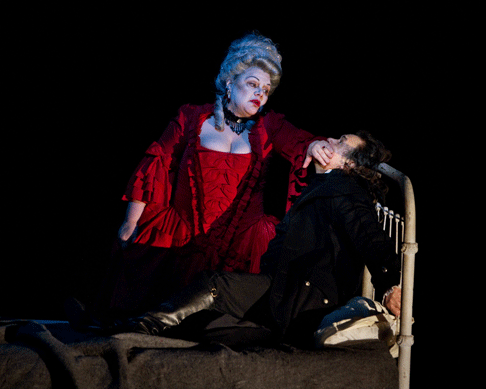 Dolora Zajick as the Countess and Vladimir Galouzine as Hermann
Dolora Zajick as the Countess and Vladimir Galouzine as Hermann
Galouzine’s voice never did have youthful bloom, and his excursions into Italian lyric roles like Des Grieux have not been happy. Curiously, his best Italian role has been Canio in Pagliacci, another man under pressure, going mad before our eyes. This is his long suit. He never gets too crazy too soon, and his bulging eyes and jack o’ lantern grins deepen in precise parallel with the developments of the story. His voice is not a thing of great beauty, but he turns its shrillness to the service of a portrait of hysteria. His Ghermann is one of the highlights of the current Russian repertory; he will be remembered nostalgically when many a more honeyed tenor takes the part. And if, short and pudding-faced as he is, he hardly looks the romantic type, imaginative adolescent girls will throw themselves at anybody, won’t they?
I missed Mattila’s Lisa when this production was new, and I’ve been kicking myself about that for years. Her figure is still striking, her acting forcible, and her voice full of beautiful notes and qualities (as she revealed singing “Ah, Perfido!” and some Sibelius songs with the Philharmonic last winter), but the easy top that once spun over the lines of Strauss’s Arabella and Chrysothemis, and made her peasant girl Jenufa credible quite recently, has faded—due to age or due to singing Puccini, I’m not sure which. (Fortunately, Makropoulos Case, for which she is scheduled here next season, goes no higher than B-flat. But Turandot? Out of the question. Ballo in Maschera? I don’t think so.) There were glorious phrases in her singing the other night, ardent girlish cries of passion and anguish, but there were also embarrassing moments when she could not maintain a pitch or, as on the final outcry of surrender of her great Act I duet with Ghermann, could not get near it at all. She covered well—she’s a singing actress the match of Galouzine, a frequent collaborator. I missed the youthful ardency of her Jenufa or Katya, but I suspect those chancy top notes will improve as she gets used to singing the role again.
Peter Mattei is so tall and slim he looks quite odd as Prince Yeletsky, and his aria to Lisa lacked the sensual yearning Dmitri Hvorostovsky brought to this lovely number. He seemed uncomfortable and cold—which may be an acting choice. We could not quite believe Lisa would break an engagement with Hvorostovsky’s Yeletsky on any account; Mattei showed us just why she would. Alexey Markov, so impressive in his brief role in Boris Godunov this season and an excellent Prince Andrei in War and Peace, took the small roles of Count Tomsky (who starts the plot rolling with his tale of the Countess and the three cards) and Plutus in the divertissement, and provided the most luxurious and pleasurable singing of the evening. Tamara Mumford, the Pauline (Borodina’s breakout role), displayed a lovely alto but needs a Russian coach. Dina Kuznetsova made a charming debut as Chloë.
Under the able if unimaginative direction of Andris Nelsons, Tchaikovsky’s sprawling score seems longer than ever. If the Met truly wants it to run shorter (and the elimination of an intermission suggests it does), they might consider cutting the divertissement in Act II. The Met chorus do “Russian” dances in a manner that can only embarrass their friends and amuse the Russians in the audience. The many charms of this opera, the first Russian work ever presented by the Met (back in 1910) and also the first to be performed there in Russian (as recently as 1972), require a bit more focus on such details as Russian accents and dance steps to create the spectacular evening the composer desired. On the other hand, at only minutes short of midnight, the theater was still full of happy opera-goers.
John Yohalem
image=http://www.operatoday.com/QUEEN_Mattila_as_Lisa_1577.gif image_description=Karita Mattila as Lisa [Photo by Marty Sohl courtesy of The Metropolitan Opera] product=yes product_title=Pyotr Il’yich Tchaikovsky: The Queen of Spades product_by=Lisa: Karita Mattila; The Countess: Dolora Zajick; Pauline/Daphnis: Tamara Mumford; Chloë: Dina Kuznetsova; Ghermann: Vladimir Galouzine; Yeletsky: Peter Mattei; Tomsky/Plutus: Alexey Markov. Chorus and Orchestra of the Metropolitan Opera, conducted by Andris Nelsons. Performance of March 11. product_id=Above: Karita Mattila as LisaAll photos by Marty Sohl courtesy of The Metropolitan Opera
Aida, London
David McVicar’s production, first seen in 2010 and here given its first revival, never wavers in its presentation of grotesque barbarism and sexual abandon — blood-thirsty gladiators run amok among nubile, naked maidens etc. — and while such goings-on may not be to everyone’s taste (indeed, some might argue that ‘taste’ doesn’t feature strongly in the proceedings), McVicar certainly injects freshness into Verdi’s old warhorse, thankfully avoiding the kitsch of cod-Egyptiana.
The first challenge for the audience is a visual one: for Jean-Marc Puissant's sets reject the beauty and exoticism of ancient Egypt in favour of dull modern industrialism: a huge wall of scaffolding, harshly illuminated by diagonal strip lights, dominates the stage. Not an elephant or sphinx in sight; but also little visual beauty to complement the tenderness of the delicate lines that open Verdi’s magical prelude. We are among a barbaric, theocratic society, one driven by human sacrifice: salacious human slaughter blesses Radamès’ departure for war, and the victims’ bloodied bodies are hoisted to form a canopy of carcasses to celebrate his return. Clearly McVicar wants to emphasise the soullessness of this brutal, compassionless community. But, at times he struggles to sustain consistency; for example, the eclectic, international selection of primitive tribal dress worn by the cast seems to have little to do with the gloomy dystopian landscape.
In the absence of a coherent mise-en-scène, it’s left to the singers themselves to provide dramatic logic and focus; and here the problems start, for the cast, while rich in musical talents, display a dearth of interest in communicating narrative or engaging emotionally with each other, preferring the stand-and-deliver approach, bellowing into the auditorium apparently impervious to the manic action occurring behind them.
There are two casts for this revival. Only one member of the original cast, Micaela Carosi, was expected to reprise her role, as the eponymous princess in the ‘Cast A’ performances; however, due to pregnancy (the official line goes …) she withdrew and was replaced at short notice by the Ukrainian soprano, Liudmyla Monastyrska. Making her house debut — she is to return in May as Lady Macbeth in Phyllida Lloyd’s production — Monastyrska revealed a powerful, opulent voice, firm and controlled in the lower register (in ‘Presago il core’, for example), and full in tone right to the top; in her great Nile scene aria, ‘O patria mia’, she floated the fiendish final phrases with ease, her breath control superb. At times, she made effective use of a dusky, exotic colouring, but it’s a shame that it was impossible to distinguish a single word of the text, and she didn’t quite have the confidence to risk the true pianissimos that the score demands.
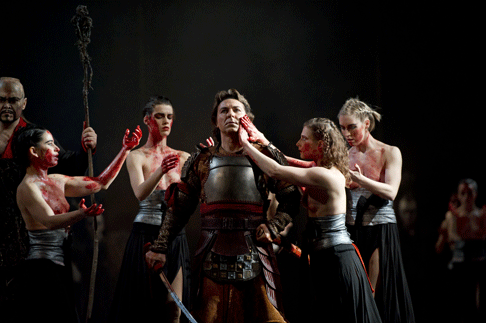 Roberto Alagna as Radames and Priestesses
Roberto Alagna as Radames and Priestesses
Roberto Alagna has an uneven history in the role of Radamès (audience displeasure with his ‘Celeste Aida’ led to his infamous walk-out at La Scala in 2006), and some have judged his voice too small for the part. However, here he showed that he now has the required vocal power; brimming with confidence, he never once lessened the ardour. Indeed, this was a puffed-up, machismo reading of Radamès, and again there was little in the way of what one might call acting. He opted out of the morendo on the high B♭ at the close of ‘Celeste Aida’, choosing instead the less risky alternative of repeating the final phrase slightly less loudly. A lack of nuance diminished the poignancy of the final duet (and the bare stage suggested that McVicar had run out of ideas by the later acts), but overall there was plenty of heroic strength and earnestness, which seemed to satisfy the crowd.
As Amneris, Russian mezzo soprano Olga Borodina was similarly impressive in vocal stature, and she achieved a true Verdian colour and warmth. She shared the theatrical weaknesses of the other principals, but her stunning, burnished tone was apt compensation. Dramatic credibility was restored by Michael Volle, a resonant and commanding Amonasro whose Act 3 duet with Aida was a rare and moving moment of engagement, interaction and insight; here, Volle truly communicated the father’s appreciation and regret that his own public actions and concerns will cause his daughter to suffer such deep private pain. In the smaller roles, Vitalij Kowaljow was underwhelming as Ramfis — perhaps his voice was muffled by his ridiculously over-sized headdress? — but Brindley Sherratt, an imperious King of Egypt, was in fine voice.
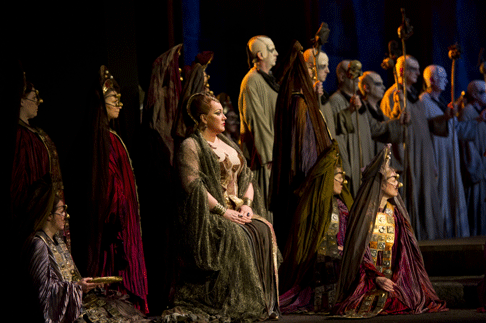 Olga Borodina as Amneris and The Royal Opera Chorus
Olga Borodina as Amneris and The Royal Opera Chorus
Apart from one or two places where singers and orchestra momentary came adrift, Fabio Luisi did an excellent job in the pit, whipping up the players in the climactic moments, and demonstrating a strong sense of the shape and pace of the whole.
Overall, despite its musical strengths and potentially intriguing concept, this production remains unsatisfying. Part of the problem is that McVicar is absorbed primarily by the ‘love triangle’ but does not connect the protagonists’ experience with the wider context. In contrast to the dynamic dramatic swiftness of Verdi’s other political intrigues, Aida is unwieldy and often downright static. One can’t get away from the fact that Verdi’s opera is a big, bold beast; the challenge is to both juxtapose and integrate the moments of private intimacy with the grand ceremony and pageantry of public triumphal processions and dances. McVicar gives us only one half of the show; Radamès’ commanding entry at the commencement of the Grand March, stage-enveloping train majestically trailing in his wake, is a rare and arresting moment of grandeur. More usually, the crowd scenes are under-directed — why have extra chorus members if you don’t know what to do with them, or simply aren’t interested? And there’s just too much standing about and arm waving: ironically, in striving for the shock of the new, McVicar has lapsed into the clichés of old.
Claire Seymour
image=http://www.operatoday.com/BC20110311183A-MONASTYRSKA.gif image_description=Liudmyla Monastyrska as Aida [Photo by Bill Cooper courtesy of The Royal Opera House] product=yes product_title=Giuseppi Verdi: Aida product_by=Aida: Liudmyla Monastyrska; Radamès: Roberto Alagna; Amneris: Olga Borodina; Ramfis: Vitalij Kowaljow: Amonasro: Michael Volle; King of Egypt: Brindley Sherratt; Messenger: Steven Bell; High Priestess: Madeleine Pierard. Conductor: Fabio Luisi. Director: David McVicar. Associate Director: Leah Hausman. Set Designer: Jean-Marc Puissant. Costume Designer: Moritz Junge. Lighting Designer: Jennifer Tipton. Royal Opera House, Covent Garden, London, Friday, 11th March 2011. product_id=Above: Liudmyla Monastyrska as AidaAll photos by Bill Cooper courtesy of The Royal Opera House
Feel Locked Out? Nothing to Tackle? Well, Try Opera
By Karen Crouse [NY Times, 15 March 2011]
Lawrence Harris, an opera singer, poked the ballroom’s faded carpet with the toe of his black alligator boot and said it reminded him of another arena he once performed in.
Lucia, New York
Despite what anyone says regarding soprano Natalie Dessay’s vocal technique or her attendance record at the Met, she is undoubtedly an exciting performer to watch. Joseph Calleja and Ludovic Tézier both bring ample good looks and stage worthiness to the table in addition to fine musicianship and distinctive voices. Director Mary Zimmerman, a 1998 recipient of a MacArthur “Genius” grant, took the theatre world by storm with her 2002 adaptation of Ovid’s Metamorphoses. So, why is this Lucia so bland?
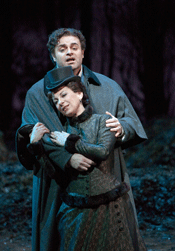 Joseph Calleja as Edgardo and Natalie Dessay as Lucia
Joseph Calleja as Edgardo and Natalie Dessay as Lucia
From the moment the curtain raises, it appears that the devil is in the details. The overture is a semi-staged affair with depressingly literal lighting effects and, when the action begins, the extremely tight false proscenium looks more like a diorama from the Museum of Natural History than a set from one of the world’s leading opera houses. During the interlude after the first scene, snow falls for no apparent reason other than to justify the large muff that Lucia wields later.
But these are relatively small concerns compared to the generic performances that Zimmerman elicits from her starry cast. Dessay, a stage animal par excellence, even seemed tentative in the first and second acts. Perhaps this was partially due to the limitations placed upon Lucia’s psychological development by making the ghost literally appear during “Regnava nel silenzio.” If Lucia is not unhinged by grief at the beginning, her affection for Edgardo falls short of passion, and the situation with her brother is only vaguely threatening in the second act, then there is little justification for her later actions.
Furthermore, in this production, Lucia appears with her bridegroom at the beginning of Act III, Scene ii and they exit the stage only moments before Raimondo enters and tells the wedding guests what has transpired in the bridal chamber. This robs the audience of seeing Lucia’s shocking transformation from obedient bride and sister into a madwoman. Even worse, the timing is completely off — the horror of the moment stems as much from the realization that the party has gone on for hours as Arturo’s body grew cold as in Lucia’s act itself. There were several such lapses in the storytelling and Zimmerman seems to have stayed too close to the original novel and done the opera a disservice by not treating it as the ripping tale it is.
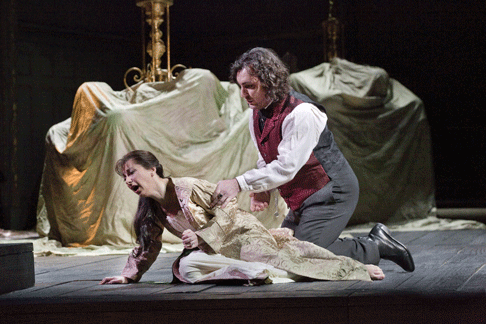 Ludovic Tézier as Enrico and Natalie Dessay as Lucia
Ludovic Tézier as Enrico and Natalie Dessay as Lucia
Within the murky and misguided production, the singers did their level best. Dessay rallied for her mad scene which transfixed the audience. Ludovic Tézier looked and sounded the part of Lucia’s brother Enrico, burdened as he was with a costume that made him Severus Snape’s doppelgänger. And while tenor Joseph Calleja was impassioned as Edgardo, unfortunately the tension between the two characters during the Wolf’s Crag scene was nonexistent due to some serious park and bark staging in front of a silly-looking scrim with a mouse hole. Kwangchul Youn was absolute luxury casting in the role of Raimondo and Matthew Plenk handled his duties as Arturo so well that it seemed a real pity to see him go so quickly.
The chorus was well-rehearsed musically but did little to convey the social turmoil that provides the impetus for the action and ultimately serves as a Greek chorus during the opera’s greatest moments of catharsis. Conductor Patrick Summers lead the reliably excellent orchestra with suavity and confidence.
With all the elements in place behind this production — including great source material, a fantastic cast, and the technical and artistic resources of the Metropolitan Opera — the results felt like a waste, much like the blighted life of the opera’s heroine.
Alison Moritz
image=http://www.operatoday.com/LUCIA_Dessay_as_Lucia.gif image_description=Natalie Dessay as Lucia [Photo by Ken Howard courtesy of The Metropolitan Opera] product=yes product_title=Gaetano Donizetti: Lucia di Lammermoor product_by=Lucia: Natalie Dessay; Edgardo: Joseph Calleja; Enrico: Ludovic Tézier. Raimondo: Kwangchul Youn. Conductor: Patrick Summers. Production: Mary Zimmerman. Set Designer: Daniel Ostling. Costume Designer: Mara Blumenfeld. Lighting Designer: T. J. Gerckens. Choreographer: Daniel Pelzig. product_id=Above: Natalie Dessay as Lucia [Photo by Ken Howard courtesy of The Metropolitan Opera]March 14, 2011
Looking at Schubert and Finding Hamlet
By Zachary Woolfe [NY Times, 14 March 2011]
The excellent English baritone Simon Keenlyside has memorably portrayed Hamlet at the Metropolitan Opera and elsewhere. And on Sunday in the TullyScope festival at Alice Tully Hall, Mr. Keenlyside — restless, eyes downcast, a little standoffish and unpredictably emotive — brought some of the same character to songs of Schubert.
La Clemenza di Tito
By George Hall [Guardian, 14 March 2011]
Mozart's final opera was commissioned to celebrate the coronation of Leopold II as King of Bohemia in 1791. This has helped condemn it as cold, rather than the living drama one expects of its composer. Yet a sympathetic staging can silence doubts.
March 12, 2011
Gheorghiu and Domingo in Giordano’s Fedora
In the case of Deutsche Grammophon and this Fedora, the booklet inside cover gives a revealing detail — the actual recording happened in January 2008. Undoubtedly the contracts were signed some time before that. The tenor lead, Plácido Domingo, was still in his 60s, and Angela Gheorghiu, in the eponymous role, had attained the height of her stardom. The work itself may not be a title for which opera fans were clamoring for a modern studio version, but it has one number everyone knows (the big second act tenor aria, “Amor ti Vieta”), so it combines some of the appeal of both rare repertoire and a known quality.
With Domingo widely celebrated this year on reaching his 70th birthday while maintaining his tenor stardom (albeit, frequently in baritone roles these days), DG surely made the right decision to release this now, or face leaving it in the vaults forever. Perhaps the latter would have been the better option. Not that the recording is some monstrous calamity. It’s more a matter that the inherent weaknesses of Fedora that have made it an obscure work on opera stages, combined with the debatable casting, lend a sad, desultory air to the set.
Conductor Alberto Veronesi comes off best. He keeps the music moving, and the frequent passages of scene-setting — not composer Umberto Giordano’s strength — have ample color. At the score’s best moments — especially the afore-mentioned solo for tenor — the momentary melodic sweep of the score can almost make a listener understand what led the DG executives to think, at one time, that this was a worthwhile project.
Based on a Sardou play, the libretto of Arturo Colautti is a narratively clumsy contraption. Too much of the confusing action happens off stage, requiring the awkward appearance of messengers and letters with necessary exposition. One can point out any number of plot discrepancies in Puccini and his librettist’s adaptation of Sardou’s later play Tosca, but the genius of Puccini at least allows for a comprehensible narrative flow, and more importantly, his music simply attains a higher level of imagination and skill.
More harmful is the baffling appeal of the soprano heroine. She starts the drama so deeply in love with a Count that when the Count is brought to her, mortally wounded after a mysterious encounter in a park, she vows revenge against his killer. In act two she feels she has located the killer in the person of one Loris Ipanov — who, for unclear reasons, has found the time to know Fedora and fall in love with her. She feels some tug of romantic attraction, but she follows up on her vow of revenge by writing a letter to Ipanov’s home country’s security forces. By act three she is totally in love with Loris, who has explained his violent encounter with the Count to her in a way that allows her to regret her vow of vengeance. However, her letter has resulted in the deaths of his brother and mother. As he vows the same sort of revenge she had vowed in act one, she drinks poison rather than face her lover as the killer of his brother and sister.
It could be argued that this scenario presents two very complex characters, combining both heroic and villainous qualities, depending on the scenario before the audience at any point of the libretto. However, the characterization is far from complex, and the result is more a mish-mash of unappealing people distraught over their own unappealing actions. Feeble subplots tacked onto the action (which still totals barely 100 minutes) don’t help.
Those who know and have some admiration for this opera will expect a larger, more dramatic voice than that of Angela Gheorghiu in the title role. She would surely be totally wrong in a stage production, but as recorded, one can at least enjoy the innate beauty of her instrument. Perhaps the ludicrous dramaturgy requires a more vehement delivery, but your reviewer was thankful not to have to put up with guttural hysterics. Domingo’s character does not appear until act two, and it is hard to understand why anyone was satisfied with the recorded take used here, as the great tenor sounds tired and the instrument uncharacteristically wobbly for much of this act, including the big aria. He seems caught in better voice for act three. In a minor role, soprano Nino Machaidze adds some acid to her light voice and makes a very good impression.
The booklet reports that Fedora was the vehicle for Enrico Caruso’s major debut, and as long as audiences enjoy a rip-roaring Italian opera aria, “Amor ti Vieta” will live on. Based on this latest recording, those two facts will continue to be the salient ones to know about Fedora.
Chris Mullins
image=http://www.operatoday.com/DG4778367.gif
image_description=Umberto Giordano; Fedora
product=yes
product_title=Umberto Giordano; Fedora
product_by=La principessa Fedora Romazov: Angela Gheorghiu; Il conte Loris Ipanov: Plácido Domingo; La contessa Olga Sukarev: Nino Machaidze. Orchestre symphonique et chœurs de la Monnaie. Conductor: Alberto Veronesi.
product_id=Deutsche Grammophon 000289 477 8367 1 [2CDs]
price=$28.99
product_url=http://www.arkivmusic.com/classical/Drilldown?name_id1=4439&name_role1=1&comp_id=1134&label_id=1068&bcorder=156&name_id=60007&name_role=3
March 10, 2011
Cecilia Bartoli in Halévy’s Clari
No matter how dubious the chosen work may be, it is sure to have one undeniable virtue for the star — a leading role that encompasses all the singer’s vocal strengths.
Although her performances in staged operas have not been numerous in recent years, there’s no bigger star in classical singing than Cecilia Bartoli. The mezzo-soprano has shown, in a series of best-selling CDs, a comprehensive interest in baroque and early Classical composers, both well-known and lesser-known. In 2008 she brought to Opernhaus Zürich a long-forgotten work of Jacques Fromental Halévy, who is best known today for La Juive, a grand opera with a showcase role for a lead tenor (Neil Shicoff has been that work’s foremost proponent in recent years). Halévy’s Clari, to a libretto by Pietro Giannone, is a very different work — more Mozartean in musical language, and with a simple story that walks an uncomfortable line between comic underpinnings and deeper emotional currents.
The title character, before the stage action begins, has been induced to leave her farm family by an attractive Duke. She expects marriage, but he ensconces her at his home and presents her as his “cousin.” As Clari begins to doubt that she will ever be the Duke’s wife, she slips toward an emotional breakdown. Finally she flees to her home, where she fears her family will no longer accept her. Indeed, her father feels she has shamed the family, but when the Duke follows her to her home, realizing at last what she means to him, the expected happy ending makes its appearance.
Bartoli’s appealing stage manner does not extend to her being a convincing actress, and in the context of the cartoonish production of Moshe Lisher and Patrice Caurier, this staging doesn’t treat Clari’s emotional predicament with sensitivity or insight. Bright colors and broad gestures dominate, as if the creators fear that the audience will grow bored if asked to concentrate on the actual libretto and score. Indeed, Halévy’s music is Mozart-lite, with anodyne recitatives and superficially appealing but quickly forgettable melodies. Apparently, Bartoli herself did not have full confidence in the score, since at key moments she performs a Rossini aria from Otello and a cavatina from an entirely different obscure work of Halévy (La tempesta). Nonetheless, the show is a pleasant enough distraction. An act two chorus sung to an ailing Clari is a beautiful little piece, and an aria sung by a minor character (Bettina, performed by Eva Liebau) struck your reviewer as better than anything Clari gets to sing. The tenor lead, Il Duca, has a nice number or two. John Osborn takes a while to warm up, sounding a bit thin in his first number, with suspect intonation. Even warmed up his voice can’t be called beautiful, but he has real vocal agility and is a scrupulous musician. Unfortunately, as costumed by Agostino Cavalica, he looks less like a handsome libertine of a Duke than an overgrown pubescent boy. The shorts are truly unfortunate.
Adam Fischer and the La Scintilla band enjoy the unchallenging score, keeping things as interesting as possible with sharp rhythms and tight pacing.
Decca offers handsome packaging, although one can’t help but suspect the show is spread over two discs just to offer the set at a higher price point. The expansive booklet features a cartoon-panel version of the synopsis (parts of which also appear in the production as a clever bit of exposition), along with an essay on the opera, a note on the production, and a “Conversation with Cecilia Bartoli,” which is about as conversational as any document emanating from a public relation’s office.
Whether or not this production actually serves as the best representation of the opera Clari, it is very likely to be the only one available, indefinitely (if not infinitely). Bartoli’s vocal charms are on full display, and the show passes the time pleasantly enough.
Chris Mullins
image=http://www.operatoday.com/Decca_0743382.gif
image_description=Jacques Fromental Halévy : Clari
product=yes
product_title=Jacques Fromental Halévy: Clari
product_by=Clari: Cecilia Bartoli; Il Duca: John Osborn; Bettina: Eva Liebau. Orchestra La Scintilla of the Opernhaus Zürich. Conductor: Adam Fischer. Stage production by Moshe Leiser & Patrice Caurier.
product_id=Decca 074 3382 [2DVDs]
price=$34.99
product_url=http://www.arkivmusic.com/classical/Drilldown?name_id1=4963&name_role1=1&bcorder=1&comp_id=362544
La Traviata, Phoenix
The play was adapted from a novel by Alexandre Dumas fils, who actually knew the real life heroine, Marie Duplessis.
When Alphonsine Rose Plessis was born on the 15th of January, 1824, in the tiny village of Nonnant in Normandy, no one could have imagined that within twenty years she would become the famous courtesan, Marie Duplessis. Her father put her to work at an early age, first as a beggar and later as a prostitute. When he was investigated for child abuse, he sent the girl to live with relatives in Paris. There, at age 15, she began to frequent dances where she hoped to meet men who would pay her living expenses.
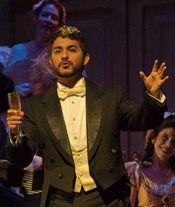 Director of the Paris Opéra Nestor Roqueplan wrote that he once saw her on
the Pont Neuf eating a green apple, but gazing hungrily at the fried potatoes
being sold nearby. He bought her a large portion and watched as she wolfed them
down and even licked the paper in which they had been wrapped. Roqueplan would
recall this incident in 1851 when he spoke with Giuseppe Verdi about bringing
La Traviata to the Opéra.
Director of the Paris Opéra Nestor Roqueplan wrote that he once saw her on
the Pont Neuf eating a green apple, but gazing hungrily at the fried potatoes
being sold nearby. He bought her a large portion and watched as she wolfed them
down and even licked the paper in which they had been wrapped. Roqueplan would
recall this incident in 1851 when he spoke with Giuseppe Verdi about bringing
La Traviata to the Opéra.
Marie worked hard at bettering herself. She not only learned to read and write, but she also attained an appreciation of the arts. When Roqueplan next saw her, he was astonished to note that the little waif from the Pont Neuf had become the fashionable lady on the arm of the Duc de Guiche.
One evening, when Marie was attending a party with Alexandre Dumas, son of the famous writer, she had a dreadful coughing spell. She explained that since there was no cure for her illness she chose to be among interesting people who would distract her from her pain. Dumas continued his affair with her for about a year, but he had to evade detection by her actual protector because he did not have anywhere near enough money to maintain her household. Another of her admirers, Franz Liszt, wrote: “She had a great deal of heart, a great liveliness of spirit and I consider her unique of her kind.She was the most complete incarnation of womankind that has ever existed.” This is the femme fatale we see on the stage as “Violetta” in La Traviata.
On March 4, 2011, Phoenix opera presented Carroll Freeman’s traditional staging of La Traviata at the historic Orpheum Theater. Peter Dean Beck’s set, originally designed for Florida Grand Opera, was easily transformed into the opera’s various scenes. John Lehmeyer’s detailed costumes set the period securely and added considerably to the opera’s visual appeal.
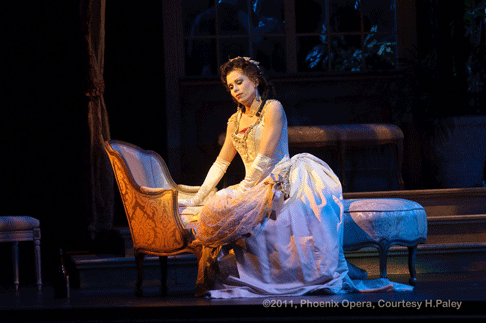
Viennese soprano Julia Koci was a radiantly beautiful Violetta who sang with taste and musicality. She is one of the few interpreters of this role who can truly handle both the coloratura of the first act and the dramatic singing required by the following scenes. Operalia winner Jesus Garcia was a passionate young lover who sang with robust, ringing tones. Together they were an ideal couple in Act I, and a pair of troubled but intriguing lovers thereafter. One could not help reaching for a handkerchief in the last act when Germont, not the soprano, read the letter which comes too late. That was an interesting choice by the director and it worked well.
Germont was sung with panache by veteran French Canadian baritone Gaétan Laperrière. He made you angry as he gave Violetta a piece of his narrow mind in Act II, but he tore at your heart strings at the end with his expressions of remorse. An attractive Flora, Erin Tompkins sang with a solid sound while Francisco Renteria was an unwavering Gastone. Alexis Davis Hazell was a poignant Annina and her husband, Earl Hazell, sang the Commissioner with a stentorian voice. Baritones Christopher Holmes and Christopher Herrera portrayed Baron Douphol and Doctor Grenvil with authority, while bass baritone Andrew Gray proved to be a commanding Marchese.
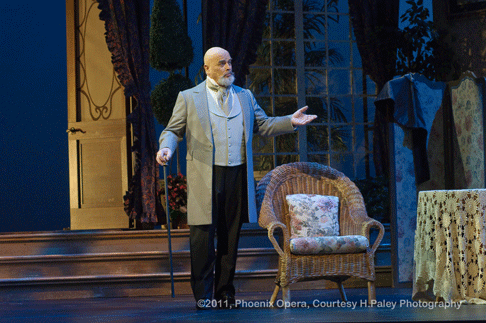
Company Founder and Artistic Director John Massaro led the rather small orchestra in a smooth, lyrical rendition of the work. The audience response at the end of the opera was tumultuous and it was fitting praise for the excellent performers who brought Verdi’s wonderful opera to life.
Maria Nockin
image=http://www.operatoday.com/HHP_PMO_Traviata_DSC_4949.gif image_description=La Traviata [Photo courtesy of Howard Paley Photography] product=yes product_title=Giuseppe Verdi: La Traviata product_by=Violetta: Julia Koci; Alfredo: Jesus Garcia; Germont: Gaétan Laperrière; Flora: Erin Tompkins; Annina: Alexis Davis; Gastone: Francisco Renteria; Baron Douphol: Christopher Holmes; Marchese d’Obigny: Andrew Gray; Dr. Grenvil: Christopher Herrera; Commissioner: Earl Hazell. Conductor: John Massaro. Director: Carroll Freeman. Scenic Design: Peter Dean Beck. Costume Design: John Lehmeyer. product_id=All photos courtesy of Howard Paley PhotographyTwo Troubled Girls in Paris
An expansive (and undoubtedly expensive) and detailed new production of Zandonai’s seldom performed Francesca da Rimini had much to recommend it. First and foremost, Svetla Vassileva has all the goods (and then some) to meet the myriad challenges posed by the title role: decent lyrical sensibilities for the limpid, introspective, (dare I say somewhat) self-pitying phrasings; good Italianate styling; and firepower galore to ride the massive orchestral surges that crop up in the final two acts. Perhaps too much firepower and a few too many decibels. There were a handful of hurled top notes that had a decided “u-wanna-see-how-loud-I-can-sing?” attitude to them that threatened to push the tone into sounding like the “All Clear” signal.
But those over-achieving moments aside, the fact is Ms. Vassileva wanted for little in providing a dramatically engaged, musically sound traversal of this demanding role. The lovely Bulgarian may have just a hint of Slavic metal in her instrument, but when she caressed some of those melting softer phrases it was like ‘buttah.’ She might benefit from dialing down the volume knob even more frequently. We can certainly hear you, Svetla! Her total involvement in the text and the drama made her an exciting partner to her co-star, local favorite Roberto Alagna, returning to the company after a considerable absence.
It was not long ago that many thought his career had irrevocably taken a step back. His performances were often more noted for his being over-parted and for cracking a top note or two than they were for the gleaming vocal excellence of his earlier promise. If his Paulo is any indication Mr. A is decidedly back on form and could justly be re-numbered among today’s leading tenors.
Perhaps the aging process has finally conferred the genuine weight on his lyrical instrument that he used to seek to impose on it in roles just outside his comfort zone. Or maybe he’s been to Lourdes. Whatever the reason, the tone has turned a gorgeous amber and his technique seems to have gone back to being grounded in the speaking voice (as opposed to the yelling voice). Having enjoyed his lyrical Romeo in Chicago some years ago, I was amazed by the maturation of the instrument and the artist. And, no minor consideration, Roberto still looks boyish and can cut a youthful figure. A perfect “Paul the Handsome” if ever there was one. His complete immersion into the confrontations and complications of his affair with Francesca made for sizzling theatre.
There was no weak link in the extensive cast of first rate soloists. George Gagnidze offered a chilling presence and wielded a searingly powerful baritone as the crippled Giovanni, perhaps ‘the’ performance of the evening. William Joyner deployed his steady, steely tenor to good end as Malatestino. Both Gagnidze and Joyner managed to balance the tricky feat of being operatically evil without being Snidely Whiplash caricatures.
Francesca’s ladies were a dynamic women’s quartet that might have been in training for duty as Rhein Maidens or wait, make that Walkűres, so ringing was their contribution. For the record they are: Manuela Bisceglie, Carol Garcia, Andrea Hill, and (first among equals) the splendid Grazia Lee. Sadly, the role of Samartina requires little of the excellent singer Louise Callinan past the first Act. It would have been nice to hear more from her. Wojtek Smilek made much of his brief appearance as Ostasion, and Alexandres Kravets was a rich-voiced Ser Toldo Baradengo. It was quite a long time before we got to sample Cornelia Oncioiu’s vocals as the attentive slave, but she made it well worth our wait, regaling us with a smooth, honey-toned mezzo.
Set Designer Carlo Centolavigna and costumer Maria Filippi have conspired to place the show in the Art Nouveau period of its composition. Much of the set design is accomplished with insets (such as the elaborate garden) co-located in the handsome drawing room of author Gabriele d’Annunzio’s Italian villa. The one nod to the story’s period is the costuming for Francesca and Paolo, which morphs into some pre-Raphaelite paraphrase. There were some lovely, evocative effects (especially of lighted portraits in a Klimt-like collage) that may not have been the final word on perfectly framing this opera, but were nonetheless atmospheric and engaging. Hans-Rudolf Kunz achieved some wonderful lighting effects and best of all, you could see the singers’ faces. (Not always so, believe me.)
I quite liked what Giancarlo del Monaco did with the staging which had good variety, motivated blocking, excellent use of the space, and sensitivity to the meaningful placement of singers. He managed to tell the story with clarity and purpose. His invention of making John an invalid in a wheelchair was quite brilliant, and made for some interesting staging effects as the cripple dominated Malatestino in a Joan-Crawford-Baby-Jane reverse face off. Hell on wheels, baby!
Daniel Oren had considerable success in the pit, drawing nuanced and idiomatic playing through the whole gamut of Zandonai’s masterful orchestral effects. He not only lovingly relished the delicate subtleties of the scoring but also whipped the group up into a bombastic frenzy as required, thereby challenging his game soloists to ride the wave of sound. They did, but a little restraint might keep the proceedings from bordering on the strident. Francesca was a celebrated role for the diva Renata Scotto, of course, and a few nights later I found myself back the Bastille for another take on a Scotto signature role, Luisa Miller.
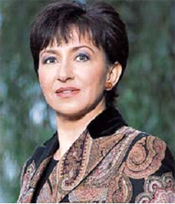 Krassimira Stoyanova [Photo courtesy of artist’s web site]
Krassimira Stoyanova [Photo courtesy of artist’s web site]
Lovely Krassimira Stoyanova does not need to worry about any comparison for she has everything required to be today’s leading exponent of the role. Like La Scotto, she can float breathtaking translucent high notes that she can swell or diminish at will. Her crystalline voice somehow manages to be bell-like at one moment and spinto-esque at the next. Her clear, poised tone manages to have considerable presence at all volumes and the registers are all treated with a seamlessly even production. She is also a poised actress and suggests a highly believable young heroine. Okay, okay, one or two of the very highest notes turn a tad brittle at forte but all told this is a major role assumption by a major artist.
As her dad, Franck Ferrari showed off a swaggering, sympathetic baritone of considerable range and power. Mr. Ferrari does pull a trick of covering the very top notes ever so slightly but it was a no-miss technique that did not distract from the overall pleasure to be derived from his vocalism. This was a notable impersonation of Miller and deserves to make the rounds of major houses everywhere.
Marcelo Alvarez was announced as indisposed before the second half, so I was mentally revising my first impression that perhaps this is a lyric voice that has most, if not all, of the resources to fully realize Rodolfo in such a large house. The phrases that called for full-throated abandon seemed to stretch him to the limit, and a high note here and there was downright effortful as he seemed to try to wrestle it to the ground. But he was indisposed so…maybe another ‘listen’ another time is in order.
Still…hmm…when he pantomimed in his curtain call that it was actually his stomach that was indisposed, I wondered if my initial reaction remained pretty much on the mark. Predictably, his Quando le sere al placido was arguably the highlight of not just his performance, but ‘the’ performance. I see that Marcelo is regularly singing roles even heavier in houses even bigger. Hope he knows what he is doing, and that his stomach holds out…
Orlin Anastassov’s Count Walter was solidly voiced if unsubtle. He seems to keep his ringing bass at full throttle much of the time and likes to linger on final notes just a bit past the cut-off. The outpouring of sound suits the role but some gradations in approach and dynamic would make it even better, and perhaps make those sinuous grupetto-like turns of phrase a little less laboriously woolly. Maria Jose Montiel made for a glamorous Federic, and it was a pleasure to luxuriate in her creamy, pulsing mezzo.
I wanted to like Arutjun Kotchinian’s Wurm more than I did for he sings with great understanding of the role, his tall, lean physique is a perfect look for the part, and he possessed of a personalized, pleasingly diffuse bass instrument. As long as he was singing at mezzo-forte Kotchinian displayed steady control over his tonal output but it has to be said when the volume and tempo ratcheted up, he occasionally strayed from the core of the pitch and smeared a few arching lines. In the small role of Laura, Elisa Cenni was startlingly good, capturing our attention in her brief appearance with her assured, characterful vocal presentation.
Daniel Oren was again in the pit and elicited thrilling results from the excellent Paris Opera Orchestra. Seldom have the strings sounded richer or more vibrant, and Maestro Oren managed to bring forth more detailed playing than I have yet encountered with this score. Special praise must be reserved for the superb clarinet solo work all evening long. Whether essaying jaunty flights of fancy, or haunting mood setting, this wonderful soloist contributed immeasurably to the musical effect. Allessandro di Stefano’s tightly drilled chorus complemented the orchestra measure for measure.
William Orlandi provided pretty much a unit set design that is pretty much, um, pretty. Pretty pretty pretty. A sumptuous Alpine drop backs a rolling, astro-turfed green meadow and other scenic elements come and go, and come back again. And go again. We are either, a) in an open-faced rustic chapel, or b) in a series of Romanesque columns, or c) in the open meadow. That’s it, pick one. All of this is framed by a rounded sweeping arch-as-false-proscenium which gives the effect of looking at a snow globe.
Orlandi’s costumes pretty much out-pretty the pretty setting, whether finely detailed folk costumes in a peach palette, or severe black courtiers, or a red-coat-with-white-pants, top hat-bearing hunting party. Indeed, it is the hunting party that arrests Miller, who apparently could not out-’fox’ them. The blame for the dim lighting goes to Joel Hourbeigt who manages to cast a shadow on nearly every singer (consistency, that’s the key), and generates all the magic of Twilight in Hoboken (with a hint of Dusk in Des Moines).
It is hard to know what stage director Gilbert Deflo actually contributed. I cannot imagine much would have altered had there been no director, for it seemed the experienced singers were left to improvise, or to variants on The Three S’s: Stand, Sing, ‘n’ Semaphore. The chorus tromped on from off left and right and stood on the sides every single time they came on, save for the men’s hunting group who got to come center stage…and stand. Luisa and Rodolfo’s blocking ran the gamut from Operetta Stance #3 to OS #4. When Miller entered to discover his daughter dying on the ground, he stood about fifteen feet away, hectoring but immobile for at least two minutes. Stood there! Your daughter is down for the count, dad, run and comfort her! Even if you use OS #5!
At best, this was a concert version in a charming setting with the highest musical values. As theatre, I dearly wished I could reach out and shake up the snow globe on display and see if some real theatre might shower down. Pity. Pretty, but…pity.
James Sohre
Cast lists:
Francesca da Rimini
Francesca: Svetla Vassileva; Samaritana: Louise Callinan; Ostasio: Wojtek Smilek; Giovanni Lo Sciancato: George Gagnidze; Paulo il Bello: Roberto Alagna; Malatestino dall’ochio: William Joyner; Biancofiore: Grazia Lee; Garsenda: Manuela Bisceglie; Adonella: Carol Garcia; Altichiara: Andrea Hill; La Schiava: Cornelia Oncioiu; Ser Toldo Berardengo: Alexandres Kravets; Il Giullare: Yuri Kissin; Il Torrigiano: Alexandre Duhamel; Il Balestriere: Nicolas Marie; La Voce del prigioniero: Ook Chung. Conductor: Daniel Oren. Director: Giancarlo del Monaco. Set Design: Carlo Centolavigna. Costumes: Maria Filippi. Lighting Design: Hans-Rudolf Kunz. Chorus Master: Patrick Maire Aubert .
Luisa Miller
Il Conte di Walter: Orlin Anastassov; Rodolfo: Marcelo Alvarez; Federica (Duchessa d’Ostheim): Maria Jose Montiel; Wurm: Arutjun Kotchinian; Miller: Franck Ferrari; Luisa: Krassimira Stoyanova; Laura: Elisa Cenni; Un contadino: Vincent Morell. Conductor: Daniel Oren. Director: Gilbert Deflo. Set and Costume Design: William Orlandi. Lighting: Joel Hourbeigt. Chorus Master: Alessandro di Stefano.
image=http://www.operatoday.com/Svetla_Vassileva.gif
image_description=Svetla Vassileva [Photo courtesy of IMG Artists]
product=yes
product_title=Riccardo Zandonai: Francesca da Rimini; Giuseppe Verdi: Luisa Miller
product_by=See cast lists in body of review
product_id=Above: Svetla Vassileva [Photo courtesy of IMG Artists]
March 9, 2011
Déodat De Séverac: Le Coeur du Moulin
A defining example of this specialty can be found in Timpani’s release of Le Couer du Moulin, a short opera by one Déodat de Séverac. Jacques Tchamkerten’s booklet essay (as translated into somewhat cumbersome English prose by Jeremy Drake) offers the expected testament to the composer (“…one of France’s…most naturally musical composers…”) to be found in a recording that a company has deemed worthy of producing. However, Tchamkerten is also refreshingly blunt about the work’s limitations, especially the unfortunate libretto, pointing out “the artificiality of its language”, the “fairly ill-defined” characters, and the “unconvincing” supernatural voices. Once past these negative comments, Tchamkerten’s embarks on a more detailed analysis of the score, relating the perceived felicities of Séverac’s compositional style — a blend of traditional harmony and the expanding orchestral palette of his countryman and contemporary, Claude Debussy.
Indeed, the essay begins with a quotation from Debussy, passing along — second-hand — a rather anodyne compliment about Séverac’s score (it “smells good”!). Even a casual listener will quickly pick up an aural sense of deja vu, as both the mood of the piece and many orchestral details sound very much like the master’s contemporaneous work, Pelléas et Mélisande. Tchamkerten points out that Debussy's opera had not premiered at the time of Séverac’s first version of his own opera, but that claim alone doesn’t prevent anyone from believing that Debussy’s work made a great impression on Séverac, an impression now heard in the final version of his work. In fact, for many listeners who lose patience with the free-floating ambience of Debussy masterwork, Séverac’s opera may strike them as a work that captures the best of Pelléas’s spectral beauty while being easier to follow and more superficially tuneful.
Ultimately, however, Le Coeur du Moulin is a rather slight work. The story is a tedious rural love triangle, encumbered with overly poetic language and devices, and with a story that promises conflict but never produces any. Jacques had loved Marie and then went away to serve as a soldier. His delayed return led Marie to believe herself abandoned, and she married Pierre. Jacques returns, whereupon he and Marie discover their love still beats on. However, the voices of nature and wise folk of the town manage to help Jacques realize he cannot interfere in Marie’s married life, and he leaves. By comparison, Pelléas et Mélisande comes off as red-blooded and rambunctious as Cavalleria Rusticana.
Listeners might do well then to skip or barely skim the provided English translation of the libretto and just enjoy the fine performance by the Tours company forces under the experienced baton of Jean-Yves Ossonce. The soloists are all effective, and the recorded sound clear and atmospheric. If one keeps one’s expectations modest, anyone who enjoys French music of the first half of the twentieth century — and why wouldn’t one? — will find this Timpani release a pleasant experience.
Chris Mullins
image=http://www.operatoday.com/Le_coeur_du_moulin.gif
image_description=
product=yes
product_title=Déodat De Séverac: Le Coeur du Moulin
product_by=Jacques: Jean-Sébastien Bou; Marie: Sophie Marin-Degor; Pierre: Christophe Berry. Orchestre Symphonique Région Centre - Tours. Conductor: Jean-Yves Ossonce.
product_id=Timpani 1C1176 [CD]
price=$39.57
product_url=http://astore.amazon.com/operatoday-20/detail/B003DW6R0O
Luca Pisaroni at the Wigmore Hall, London
Extremely erudite choice of programme too. When Pisaroni started singing, it fell into place. He’s primarily an opera singer and a specialist in Italian repertoire, Mozart and baroque. He even grew up in Busseto, Verdi’s birthplace, so he could coast to the top “to the manner born”.
So the fact that he chose an unusually intelligent programme says a lot about his versatility and musical instinct. He’s also smart enough to have figured out the Wigmore Hall ethos. Although the auditorium wasn’t full, those who were there were the real cognoscenti, serious listeners who really appreciate good singing (and good programmes). Some of them are getting on in years and don’t get out as much as they used to, so the fact that they were there is a huge compliment to Pisaroni.
And Pisaroni delivered! Schubert wrote several operas in Italian, but instead of singing “bleeding chunks”, Pisaroni picked Drei Gesänge D902 (Metastasio, 1827), which look like excerpts but were written as stand-alones. This integrity brings them closer to Schubert’s song repertoire. They’re Italianate but Schubert’s Austrian aesthetic is clearly distinct. Pisaroni placed the last song in the group first, Il modo di prender moglie (How to choose a wife — for money!), which was a good idea. It’s a strophic comic ballad which doesn’t make great demands — lulls you into forgetting who the composer might be. Then, the first song L’incanto degli occhi (The magic of eyes) where the true Schubertian voice is unmistakable. What a witty juxtaposition! Pisaroni not only has an amazingly good voice, but musical intelligence, too. Then you appreciate the humour in Il traditor deluso (The deluded traitor) which isn’t morbid, despite the title. When Pisaroni sang “Ove son io?” (Where am I?), he repeated it cryptically, I had a vivid mental image of Schubert, frustrated by having too little success in a genre he needed to master if he’d compete with changing fashions.
Hence, Rossini. Again, Pisaroni chose songs rather than bits from popular operas, to connect better with Schubert. Pisaroni is a bass baritone, so the darker timbres were extremely beautiful, but the voice is agile and flexible, so the transits upwards come with ease. Truly a gorgeous voice, full of nuance and colour.
Franz Liszt wrote transcriptions of Schubert’s songs which are still popular today, though they sound much more Lisztian than Schubertian. They’re florid, as if Liszt can’t quite get the Lieder aesthetic and submerges it in too many notes. That’s fine, they’re different composers. Liszt also knew Schumann, the “new music” of the 1840’s. There are well over 70 Liszt songs for voice and piano, but Pisaroni again chose thoughtfully. Two settings of Heine, one of which, Im Rhein im schönen Strome is indelibly associated with Dichterliebe and Schumann. Liszt’s S272 (1855) is a more studied piece, reflecting a different approach to song, which is quite distinct, though the text in the last verse demands similarly strong phrasing.
Pisaroni and Rieger followed with three songs Schumann didn’t set, to emphasize Liszt’s unique style. There are vaguely Schumannesque passages in the piano parts, though Liszt doesn’t write extended preludes and postludes. Der Vätergruft (1844, Uhland) displays Liszt’s gifts as dramatist. The ghost of a knight joins his ancestors in their tomb. “Die Geisterlaute verhallten, da mocht es gar stille sein” (Ghostly sounds fade and silence reigns again). This could almost be a song without words, it’s so effective.
This extremely well planned recital ended with Liszt’s Tre sonetti di Petrarca S270 in the version for baritone and piano. Liszt as pianist triumphs. This isn’t Germanic Lieder by any means but completely unique. Reiger played with great delicacy, matched by Pisaroni’s sensitive modulation. His Benedetto sia’l giorno is truly a love song. He lingers gently on the words “E i sospiri e le lagrime” so they feel like a gentle caress. An exquiste recital wonderfully realized. Next time Pisaroni appears, there should be queues around the block. He’s singing Argante in Handel’s Rinaldo at Glyndebourne this summer with Sandrine Piau, who did fascinating programme of Schubert transcriptions last week. (See review here) So we’ve heard both Pisaroni and Piau in two unusual recitals in the same week at the Wigmore Hall. Brilliant!
Anne Ozorio
image=http://www.operatoday.com/Luca_Pisaroni.gif
image_description=Luca Pisaroni
product=yes
product_title=Luca Pisaroni sings Schubert, Rossini and Liszt
product_by=Luca Pisaroni, bass baritone, and Wolfram Reiger, piano. Wigmore Hall, London, 6th March 2011.
product_id=Above: Luca Pisaroni
March 6, 2011
Dialogues des Carmélites, Guildhall, London
Dialogues des Carmélites is an unusual opera because it unfolds as a series of disconnected tableaux, like the Stations of the Cross. This structure is significant, for Poulenc is connecting the nun’s journey to the guillotine to Christ’s journey to the cross. The narrative is deliberately stylized to emphasize the spiritual and moral implications of the plot. It’s not simple narrative.
Poulenc further emphasizes the non-linear progression by writing expressive interludes which are as much part of the story as the text. This subtle distinction can be lost in productions that treat the opera as straightforward drama. Instead, at the Guildhall the staging respects Poulenc’s musical and theological structure.
Dark, fractured shards shroud the stage. They shards resemble broken glass, as if the audience is peering through a window that has been shattered. For the French Revolution has shattered society: everything’s being smashed, the convent, the aristocracy and innocent lives. It’s also a vivid metaphor for Poulenc’s edgy, angular music thrusts and cuts relentlessly. No easy lyricism here even if Poulenc’s idiom is easier on the ear than many other composers might be, given such material. This production, directed by Stephen Barlow and designed by David Farley, is impressive because it’s so musically astute.
There are no less than 12 scene changes in this opera excluding the three extended interludes, which creates many technical problems. This staging is simple - boards covered by what looks like velour - but it’s effective. Between the many different tableaux, the shards close together, hiding the stage from view. This focuses attention on the crucial “scenes” in the orchestra. Lit from behind, the shards esemble rocks (lighting design: Declan Randall). Dramatic momentum isn’t lost because the scene changes are so quick.
This is what good stagecraft should be, created around music and meaning. This isn’t a typical opera because it’s very direct and to the point. Because the music is so formal, and the philosophical choices so stark, too much fussy literalism would act against the very purpose of this opera. There are men in uniform (just as the nuns are in uniform) but the horrific scene at the Place de la Revolution is treated with restraint on the stage.
The guillotine is shown only in the distance, hidden by the mob, who are dressed in shades of red. As the mob moves, the red mass moves, like a gory stream of blood. No need to depict the executions, for the image expresses so much and allows the nuns their dignity. They stand in a line confronting the audience. In real life they’d hardly be wearing immaculate vestments, but spiritually they’re already among the angels, as one by one, each nun is picked out by spotlight. At last the shards are vanquished, like the barbarism they depict. Sister Blanche of the Agony of Christ is shown alone in a moment of glory, transfigured with light.
Barlow, Farley and Randall are professionals. Barlow is well regarded for his work at Opera Holland Park, London. Although he’s young, he’s also worked at the Royal Opera House, Glyndebourne and the Met. This exchange between professionals and students is fruitful, because the students learn the business as it’s practiced in the market.
It’s a pleasure to watch how the GSMD students respond. For a change, they’re acting very well, for Barlow’s good at directing people. Very natural movement, often closely co-ordinated with musical detail. Nicely blocked crowd scenes, concentrated when needed (as in the mob), diffuse when the nuns feel isolated in their travail. The nuns are treated like individuals, which is what they are, despite the regimentation of the Carmel. Principals are well cast too - it’s good to hear familiar voices get good exposure.
The role of Blanche in Dialogues des Carmélites is interesting, because Poulenc isn’t explicit but hints at worrying traits of neurosis and self-delusion. Something’s very not right about a girl who screams at the butler’s shadow and causes her brother such anguish. Nowadays such girls wouldn’t be accepted into the novitiate. Whoever sings Blanche needs to fill in the backstory for herself, so it’s convincing when Blanche’s resolve develops and makes her sacrifice. Anna Patalong sings 3/3 and 7/3, Natalya Romaniw on 5/3 and 9/3. They’re both major names at GSMD, attractive voices and reliable.
Blanche is emotionally vulnerable while the old Mother Superior, Madame de Croissy (Cátia Moreso) seems strong but dies a traumatic death. It’s a high point in the opera because it reverses the idea of a pious person being free from doubt. Moreso sings with a force that belies her supposed physical weakness, but Poulenc’s not into literalism but spiritual veracity. Just as Blanche’s music is hyper, so is Mme de Croissy’s, though of course in different ways. Both are more affected by the turmoil around them than they let on.
Mère Marie (Sylvie de Bedouelle and Amy J Payne), Mère Jeanne (Sioned Davies) and Madame Lidoine (Sky Ingram) are all strong, conventional characters. The book that inspired the play on which Poulenc based his opera was written by a German feminist, Gertrud von le Fort, who could see what was happening around her in the 1930’s. The French Revolution didn’t have a monopoly on mobs. The male principals too are relatively conventional parts, very solidly created. Gary Griffiths and Koji Terada alternate as the Marquis de la Force, Charlie Mellor and Paul Curievici as the Chevalier and Alberto Sousa sings the Priest
The role of Soeur Constance is sometimes underestimated. She’s the nun who drives Blanche to distraction because she’s irrepressibly cheerful. Sophie Junker sings the part vivaciously, for Barlow directs her to leap and dance. Psychologically right, although Carmelites are a semi-silent order. Constance isn’t a typical heroine, but she’s central to the plot because it’s she who understands what the Mother Superior’s death means, throwing the nun’s eventual deaths into perspective. .
Yet Dialogues des Carmélites, despite its religious subject, isn’t as solemn as might seem. It’s distinctively Poulenc, and Poulenc is sardonic. Blanche is devout but her music verges on deranged. The Prioress acts like she’s older than Methuselah but she’s only 59 (and Poulenc lets us know exactly how her life was divided). Her death scene’s over the top, so the nuns are shocked. This is doubly ironic when you realize Poulenc’s best friend was dying when he wrote this music. Perhaps it’s a form of whistling in graveyard, avoiding pain by denying its power. Typical Poulenc irony. Listen to some of the key wind parts, too, especially the sour-sweet solos, and the raucous churning in the strings. Soeur Constance’s lively spirit could come straight out of Banalités (which are anything but banal) or Les mamelles de Tirésias. Poulenc’s elegant, ironic wit cannot be silenced any more than the nuns’ faith can be suppressed.
Anne Ozorio
image=http://www.operatoday.com/Our_Lady_of_Mount_Carmel_Ch.gif
image_description=Our Lady of Mount Carmel Church, Quidenham, Norfolk - Windows Two of 16 windows in the clerestory [Source: Wikipedia]
product=yes
product_title=Francis Poulenc: Dialogues des Carmélites
product_by=Marquis de la Force: Gary Griffiths, Koji Terada, Le Chevalier: Charlie Mellor, Paul Curievici, Blanche: Anna Patalong, Natalya Romaniv, Thierry: Matthew Wright, Madame de Crioissy: Cátia Moreso, Soeur Constance: Sophie Junker, Mère Marie: Sylvie de Bedouelle, Amy J Payne, Mère Jeanne: Sioned Davies, Madame Lidione: Sky Ingram, Monsiuer Javelinot: Matthew Stiff, L'Aumonier: Alberto Sousa, Soeur Mathilde: Roisin Walsh, Premier Commissaire: Alexandros Tsilogiannis. Conductor: Clive Timms, Director: Stephen Barlow, Designer: David Farley, Lighting: Declan Randall, Video design: Chris Jackson. Guildhall School of Music and Drama, London, 3, 5, 7 and 9th March 2011.
product_id=Above: Our Lady of Mount Carmel Church, Quidenham, Norfolk - Windows Two of 16 windows in the clerestory [Source: Wikipedia]
L’Africaine, OONY
Hollywood’s historical style, especially the epics with spiritual content, took its cue from Scribe, and the idea of accompanying the pageant with a thrilling but shallow score may also derive from these operas. In any case, the Scribe-Meyerbeer firm achieved this very well; their operas, expensive as they were to produce properly, were much loved for a hundred years. Changes in the style of singing, the onset of highfalutin Wagnerian music-drama, which outclassed grand opera, and the sheer cost of putting this grandeur on stage (six or seven leading singers were not the least of it—but ballets of ice skaters or ghostly nuns, sixteenth-century bathing beauties with pool, a full-rigged galleon overwhelmed by a typhoon—don’t none of it come cheap) fell victim to the Crash of 1929.
Revivals of their four grandest collaborations, not to mention the lesser ones, have been so rare since World War II that it is easy to keep track (and own pirates) of most of the grandest (the Sutherland-Corelli-Simionato Gli Ugonotti in Milan, the Ramey-Anderson Robert le Diable in Paris, the Leech-Lorengar Des Hugenotten in Berlin, the Horne-McCracken Prophète at the Met, the Verrett-Domingo L’Africaine in San Francisco). L’Africaine, the final (and posthumous) Scribe-Meyerbeer creation (premiere 1865), was last staged in New York in 1934 with Rethberg, Martinelli and Pinza. It was last heard here in concert in 1972, when the brand new Opera Orchestra of New York gave it for Richard Tucker to show off his stalwart ut de poitrine as Vasco da Gama. Eve Queler, who is standing down as maestra for the company she has steered through so many shoals past so many Capes of Good Hope, presented it again last week as her farewell to the podium.
 Marcello Giordani [Photo by Dario Acosta]
Marcello Giordani [Photo by Dario Acosta]
L’Africaine has everything—except Africa or Africans.
(The plot changed over years of rewriting but they forgot to change the title,
and both men had died before the premiere.) L’Africaine
certainly had everything Meyerbeer’s audiences expected: big arias and
loud duets for singers with range and staying power, orchestral variety, insane
stage effects, local color run riot, chorale, ballet. There are so many
characters in Act I that we are relieved when a catastrophe in Act III reduces
the story to manageable size, their stage-filling Portuguese galleon having hit
a reef (thanks to an invocation of a god of the winds) where bloodthirsty
savages overwhelm the crew. This still leaves two acts of romantic mayhem,
oriental religious rituals and the opera’s most famous aria, “O
Paradis” before a bittersweet conclusion: The savage but noble queen
sends her adored Vasco and his Portuguese sweetheart home, then eats poisoned
crimson flowers on a cliff overlooking the sea. (Yes, this situation was
borrowed for Aida and Gioconda.) Unfortunately for the peoples of the
Orient, the lovesick queen also gives Vasco navigational secrets with which to
found a colonial empire, but in 1865 that was just what all the opera-loving
countries wanted to do. “O Paradiso” (as it was sung in Italian, by
Caruso, Gigli, Martinelli et al.) became, in a way, the theme song of the
age.
L’Africaine’s rare full revivals (most recently, in this country, in San Francisco in 1988, with Shirley Verrett, Plácido Domingo, Ruth Ann Swenson and Justino Diaz, a production available on video) never fail to delight those audiences who like their opera grand, with big tunes, big voices, long nights and manic spectacle. Its repute (both good and bad) pretty much guarantees an audience of the curious, and Avery Fisher Hall was packed to the rafters on the present occasion, despite the lack of well-known singers other than Marcello Giordani. Just, you know, to hear the thing. Most of us were still hanging on three and a half hours after Maestra Queler raised her baton (and there was only one intermission). And as soon as we heard a massed basso chorus threatening violence in the name of intolerant religion (a familiar Scribe trope), accompanied by a piccolo, we knew we were in Meyerbeer country. (Scribe gets it twice in L’Africaine—the raging basses are Catholics in Act I, when they wish to kill Vasco for attempting to circumnavigate Africa, and they’re bloodthirsty Brahmins in Act IV, when they want to kill him lest he go home and reveal the secret route.)
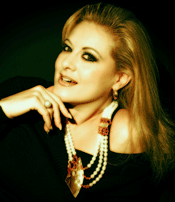 Chiara Taigi
Chiara Taigi
Eve Queler has been running this show for forty years and her conducting
style isn’t going to change. How dancers would follow her languid beat
through Meyerbeer’s exotic ballets is hard to imagine, but happily this
is not a requirement in concert performances; the singers had merely to stand
out and declaim. The pace of the evening did not flag, the climaxes and
confrontations were a thrill. For example, the xenophobic Brahmins inserting
cries of “No!” into Vasco’s pleas for mercy were a nice
Meyerbeerian touch, though of course stolen from Gluck’s Orfeo,
which the Opéra had recently revived for Pauline Viardot. The tenor-bass duet
in Act III, as Vasco and slimy Don Pedro nearly come to blows over the lovely
Inèz, is even more exciting because we know the typhoon is blowing up. The
soprano-mezzo battle over the tenor (again: Verdi and Ponchielli were paying
heed) enlivens Act V while the conclusion is still in doubt. It was an evening
of crowd-pleasers.
Besides showing off scores we are unlikely to encounter staged, Opera Orchestra’s other great function has been to introduce New York to singers we may not otherwise encounter. OONY’s alumni are quite a roster. That last L’Africaine, for example, paired Tucker with Antonietta Stella. OONY’s Les Huguenots, a triumphant occasion and a rare performance of nearly the entire score, gave us not only the New York debut of Krassimira Stoyanova as Valentine but the superb Raoul of Marcello Giordani. Giordani, for whatever reason, never sounds so good, so heroic, at the Met (where he sometimes sings the same roles) as he does when performing with OONY, and L’Africaine showcased his Vasco da Gama, some of the noblest, most robust singing he has given New York in many years, though not without an occasional bobble.
Giordani was joined by a curious roster of strangers and familiar faces in unusual roles. Among the strangers was Chiara Taigi, an Italian soprano of striking looks and high melodrama in the acting department, showing off three different costumes to suit Sélika’s three roles of lovelorn slave girl, restored queen and suicidal abandoned lover. The role is as juicy as, well, a Meyerbeer heroine, but sits awkwardly for the voice, mostly high mezzo with some soprano extension. Rosa Ponselle, whose voice ran precisely there, had a tremendous success with it, but no one living has the technique, much less the gift, of a Ponselle. Taigi’s top notes were rough and the joints sometimes showed, but it is a prima donna-sized instrument with some very beautiful material in it. I’d be curious to see her in more basic repertory, but I’m not sure which—the list of roles in her bio is all over the map, and her emoting may not suit the modern “realistic” school. In an OONY evening, she was just what we wanted.
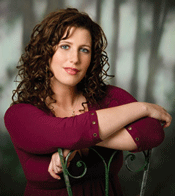 Ellie Dehn [Photo by Dario Acosta]
Ellie Dehn [Photo by Dario Acosta]
Ellie Dehn, who sings an odd assortment of parts at the Met (I loved her in
Satyagraha), sang the role of Vasco’s girlfriend, Inèz, with
some brilliant color but imperfect coloratura. A South African baritone named
Fikile Mvinjelwa—short, barrel-chested, dark-skinned, a voice to reckon
with and an actor to his fingertips—took advantage of all the quirks of
Nélusko’s sinister-heroic personality without reticence and brought down
the house with his “Adamastor, roi des vagues.” (He’s been
covering roles like Rigoletto at the Met; I say: Turn him loose to sing them.)
Daniel Mobbs, ever reliable and elegant, sang selfish Don Pedro suavely. Ezio
Pinza was wont to sing both the Grand Inquisitor and the High Priest in the old
days—more Scribean commentary on the universality of religious
intolerance—but Queler gave them to sturdy rival basses.
It was a performance to make us all hope to be around the next time L’Africaine comes back—and more eager still to hear a Robert le Diable or Dinorah or Crociato in Egitto.
John Yohalem
image=http://www.operatoday.com/Meyerbeer.gif image_description=Giacomo Meyerbeer product=yes product_title=Giacomo Meyerbeer: L’Africaine product_by=Sélika: Chiara Taigi; Inèz: Ellie Dehn; Vasco da Gama: Marcello Giordani; Nélusko: Fikile Mvinjelwa; Don Pedro: Daniel Mobbs; Grand Inquisitor: Djoré Nance; High Priest: Harold Wilson. Opera Orchestra of New York and New York Choral Ensemble conducted by Eve Queler. Performance of March 2. product_id=Above: Giacomo MeyerbeerGilbert & Sullivan: The Mikado
Miller’s long-runners have been ubiquitous on London’s operatic stages of late — Così and Don Pasquale at Covent Garden, and (in combination with a new L’elisir d’amore), La Boheme, Rigoletto and now The Mikado at the Coliseum. And, the director’s enthusiasm for revisiting and refreshing past projects seems undiminished: having involved himself with this latest revival, he appeared on the opening night to oversee the topsy-turvy affairs.
A superb cast rose to the occasion. As a no-nonsense Yum-Yum, Sophie Bevan delivered ‘The Sun Whose Rays’ which brightness and buoyancy — a moment of ‘normalcy’ among the mayhem. Alfie Boe — kitted out with kiss-curl and blaring blazer — is a Tigger-ish Nanki-Poo, all enthusiasm and bounce; perhaps a little uncertain of his dramatic direction initially, Boe’s wide-eyed innocence came through more effectively in Act 2. His warm, flexible tenor conveyed both youth and sincerity, and matched Bevan’s timbre and colour most pleasingly.
Alongside the drolleries of the young lovers’ courtship, Donald Maxwell’s Pooh-Bah was hilariously haughty; he possesses a powerful baritone, but his strong speaking voice boomed with equal sonority, his Scottish brogue bellowing to the far reaches of the auditorium. Richard Angas, a veteran Mikado of Japan, returned to the role once more; Angas was vocally secure and presented a well-studied portrait of indifferent imperiousness, his understated authority possessing just the right hint of menace.
Anne Marie Owens’ Katisha, glamorously be-jewelled, was perhaps not sufficiently harridan-esque. She effectively brought out the pathos of the role, but was rather too good at arousing our pity. And, she struggled at times to project successfully. Claudia Huckle was more at home in the role of Pitti-Sing: her contralto is clear and bright, and she acted the dialogue entertainingly. Frances Canfield, as Peep-Bo, made the third of a fine trio in ‘Three Little Maids’, although the absence of choreography here (when elsewhere all was manic movement and fizz) was rather a weakness.
The dialogue coach, Selina Cadell, has clearly worked hard to implant the rules of cut-glass R.P. among the cast and chorus, and the distorted vowels certainly come from the back of the throat. There’s always the danger of over-kill, but here and through other conceits Miller captures the essential ‘artifice’ of the work. Nowhere is this made more wryly apparent than with the extravagant preparations for Ko-Ko’s entry, which is anticipated by the kowtowing court with trumpet voluntaries, elaborate genuflections and splashes of rose-petal confetti, only for the high-and-mighty-one to fail to appear … and so, eyes are rolled, grins are fixed, petals are hastily gathered up and the entire sequence is repeated. The zany choreography and props — sashaying headless servants and a fat-suit for The Mikado — together with the over-bright, gleaming lighting, add a frisson of surrealism and risk. Such details scratch at the façade of the dazzling white-and-cream hotel lobby, and perhaps hint at the latent instability of the edifice: Titipu may not ready to topple yet, but there’s the danger of least a wobble or two.
In the pit, Peter Robinson kept things ticking along with precise and well-judged comic timing; if anything the orchestra was a little ‘restrained’, but perhaps this was to allow the text to shine, and Robinson was certainly sensitive to the singers in this regard.
The entire cast, including the shimmying maids and the bopping bell-hops, were clearly having a marvellous party. The engine driving the show is, however, the Lord High Executioner himself, Richard Suart, whose unprincipled, unscrupulous Ko-Ko is effortlessly slick. Emphasising the Executioner’s self-interest and opportunism, Suart’s Ko-Ko is deliciously cynical. Surprisingly he manages to balance slapstick and hamming with innuendo and suggestion. Casting an eye at both the political leader columns and the celebrity gossip pages, his ‘little list’ of those ‘for the chop’ has naturally been updated, and this time around deluded Arab dictators, mincing coalition politicians, philandering footballers, affianced royals and, inevitably, Silvio Berlusconi, all found themselves in the firing line. Suart’s comic timing is superb; he pauses to relish the sharper moments, before rushing on to the next joke, keeping the audience hooked, ever-ready for the next bombshell. His mimicry is spot on, encompassing models as divergent as Olivier’s Richard III, Frankie Howerd and Gordon Brown.
The perfect visual and dramatic embodiment of G.K. Chesterton’s observation that, in fact, none of the jokes in the play fit the Japanese but ‘all the jokes in the play fit the English’, Miller’s 1930’s hotel-foyer staging seemed inspired at its first appearance, has proved itself both reliable and perpetually inventive, and is fast assuming the epithet ‘classic’. At the end of this run, no doubt the costumes will be carefully wrapped in tissue paper, as I don’t expect that this is the last we’ve seen of this production. In contrast to the ‘victims’ on Ko-ko’s list, it really would be missed.
Claire Seymour
image=http://www.operatoday.com/Mikado.gif" image_description=The Mikado product=yes product_title=Gilbert & Sullivan: The Mikado product_by=Ko-ko: Richard Suart; Nanki-Poo: Alfie Boe; Yum-Yum: Sophie Bevan; Pooh-Bah: Donald Maxwell; Katisha: Anne Marie Owens; The Mikado: Richard Angas; Pish-Tush: William Allenby; Peep-Bo: Fiona Canfield; Pitti-Sing: Claudia Huckle. Conductor: Peter Robinson. Director: Jonathan Miller. Associate Director: Elaine Tyler-Hall. Set Designer: Stefanos Lazaridis. Lighting Designer: Davy Cunningham. Choreographer: Anthony van Laast. Revival Choreographer: Stephen Speed. Dialogue Coach: Selina Cadell. English National Opera, Saturday 26th February 2011.Roderick Williams, Wigmore Hall
Williams opened with an intimate presentation of six songs from Hugo Wolf’s Italienisches Liederbuch, conveying both the simplicity and immediacy of the emotions expressed in these miniature outpourings of love. ‘Gesegnet sei, durch den die Welt entstund’ (‘Blessed be he, who created the world’) displayed Williams’ assurance and control, as he diminished from a striking fortimisso to a delicate pianissimo, as the poet-speaker blesses the one who ‘made beauty and your face’ in a hushed whisper of awe and devotion. Rhythmic energy characterises ‘Schon streckt’ich aus im Bett’ (‘I’d already stretched my tired limbs’), and Deutsch’s flexible playing underlined the exuberance of the poet who, dreaming of his love, leaps from his bed to roam the streets serenading his beloved. Williams’s gentle tone conveyed the heartfelt sensuality here, but was aptly replaced by a more declamatory style in ‘Geselle, wollin wir uns in Kutten hüllen’ (‘Comrade, shall we disguise ourselves in cowls’), and by an earnest directness, supported by Deutsch’s rippling spread chords, in ‘Und willst du deinen Liebsten sterben sehen’ (‘And if you would see your lover die’). The vision of his lover’s golden hair leaves the poet almost speechless (‘the hair is beautiful, beautiful she that wears it!/ Golden threads, silken threads without number —’), and Willams achieved a tremulous sense of wonder and incredulity, floating the phrase ‘Schön Sind die Haare’ (‘the hair is beautiful’) with superb grace, while Deutsch more than matched this expressivity in the harmonically rich postlude.
The upper register of Williams’ voice is secure and focused, but the lower register is no less interesting, and in ‘Sterb ‘ich, so hüllt in Blumen meine Glieder’ (‘If I should die, then shroud my limbs in flowers’) he strove for a veiled quality which complemented the low accompanying pedal, before rising to a transcendent, ethereal conclusion, ‘Ich sterbe lieblich, sterb’ ich deinetwegen’ (I’ll die happy if I die for your sake’). Deutsch launched into the final song, ‘Ein Ständchen Euch zu bringen kam ich her’ (‘I have come here to sing a serenade’), with an energetic staccato and the performers romped through to the insouciant close. Above all, it was the ease with which Williams moved between moods, registers and timbres which was most impressive.
Erich Wolfgang Korngold is best known for his film scores, and perhaps for the opera Die tote Stadt, but interest in his music has grown in recent years (with recordings made of the Violin Concerto, Symphony and string quartets), and the Vier Lieder des Abschieds Op.14 (4 Songs of Farewell) certainly deserve to be heard more often. Composed in 1919, when Korngold was 23-years-old, they present different types of farewell, and employ a Straussian Romantic idiom enriched by increasingly complex chromaticism, wide vocal intervals, and other effects such as glissandi; indeed, the precision of the composer’s instructions is almost overwhelming, only 2 of the 200 bars being free of detailed performance markings.
‘Sterbelied’, a translation of Christina Rossetti’s famous sonnet, ‘Remember’, enabled Williams once again to demonstrate the flexibility of his voice, as he moved effortlessly between registers in the line, ‘Und wenn du willst, vergiß’ (‘and, if you will, forget’), and effectively employed a head voice towards the wistful close. Deutsch captured the emotional weight of ‘Dies eine kann mein Sehnen nimmer fassen’ (‘This one thing my longer can never grasp’), and the performers shaped the song superbly, climaxing with the final frightening image of the poet’s fate — ‘the boundless depths of its darkness’. Ernst Lothar provided the text for the final two songs, ‘Gefaßter Abshied’ (‘Resigned farewell’) and ‘Mond, so gehst du wieder auf’ (‘Moon, thus you rise once more’) where Williams presented an array of colours to convey the fierceness of the poet’s painful grief: ‘Das Herz, das sich mußt’ trennen,/ Wird ohne Ende brennen’ (‘the heart that has suffered separation/ will burn eternally’).
After such intensity, four songs from Mahler’s Des Knaben Wunderhorn offered some lightness and humour, with Deutsch enjoying the mischievous rhythmic displacements and raucous postlude of ‘Um schlimme Kinder artig zu machen’ (‘How to make naughty children behave’). In these songs, Williams was able to demonstrate his considerable skill at characterisation, here using his face and body most expressively to complement the jaunty rhythms that convey the arrival of the gentleman on horseback. The beauty of his upper register was again displayed in ‘Ich ging mit Lust’ (‘I walked joyfully’), and a dream-like quality was achieved in ‘Erinnerung’ (‘Recollection’) as the poet speaks of ‘The lips that dream of your ardent kisses’. In ‘Aus! Aus!’ (‘Out! Out!’), a young soldier reassures his lover that, although he is soon to march off to war, their love is far from over; she doubts him, and laments that she will enter a convent. Williams and Deutsch captured the irony in Mahler’s setting — which plays on the pun that ‘aus’ can mean both ‘out of town’ and ‘finished’ — the repeating refrain leaving us in no doubt of the young man’s immaturity and frivolousness.
After the interval we returned to the first half of the nineteenth-century, with Schumann’s 12 Kerner Lieder Op.35. There is an extraordinary range in both texts and musical style in these settings, perhaps indicative of the swings of mood that Schumann suffered throughout his life, but Williams and Deutsch shaped them into a coherent whole, carefully judging the passage between songs, emphasising both contrast and continuity. After the exhilaration of ‘Lust der Sturmnacht’, the performers established a mood of still solemnity in ‘Stirb, Lieb' und Freud!’ (‘Die, love and joy!’): Deutsch’s continuous, right-hand melody evoked a spiritual calm and was matched by Williams’ smooth lyricism. The young girl’s prayer to the Virgin Mary, ‘O Virgin pure!/ Let me be/ yours alone’, was delivered without vibrato, indication once again of the baritone’s technical control. A ghostly aura was created in ‘Auf das Trinkglas eines verstorbenen Freundes’ (‘To the wine glass of a departed friend’), the unison phrases shared by piano and voice perfectly attuned and shaped. Williams suggested the contemplative depths of the poet-speaker’s realisation that friendship is eternal, an understanding which brought fresh movement and light into the closing stanzas of the song. ‘Wanderung’ (‘Wandering’) followed swiftly on, Deutsch’s rocking triplet rhythms conveying the traveller’s light-hearted spirit and springing step.
The final five songs are more ruminative and questioning. The piano’s role in creating ‘meaning’ was superbly demonstrated by Deutsch at the close of ‘Stille Liebe’ (‘Silent love’), where his delicately ornamented cadence wonderfully enhanced the mood of quiet regret. Williams’ breath control was splendid in ‘Stille Tränen’ (‘Silent tears’), where he made much of the chromatic rise which presents the image of a man who ‘will often weep out his sorrows’. We closed on a desolate note, the spare accompaniment of ‘Alte Laute’ (‘Sounds from the past’) reminding us of the emptiness of the present, as the poet-speaker laments that all joys have now passed, and ‘only an angel shall wake me’ (‘Weckt mich ein Engel nur’). Williams’ composure and control were outstanding as, slower and softer, the rather unemotive melody of the preceding song, ‘Wer macht dich so krank?’ (‘Who made you so ill?’) returned, drawing the cycle to a bleak conclusion.
The exuberant applause was much deserved for one cannot imagine these songs being better sung. Williams’ verbal clarity was excellent throughout; he genuinely understood the texts and conveyed their rich and diverse meanings with thoughtfulness and sincerity.
Claire Seymour
image=http://www.operatoday.com/Williams-Roderick.gif image_description=Roderick Williams [Photo courtesy of Ingpen & William] product=yes product_title=Roderick Williams, Wigmore Hall product_by=Roderick Williams, baritone; Helmut Deutsch, piano. Wigmore Hall, London, Friday, 25 February 2011. product_id=Above: Roderick Williams [Photo courtesy of Ingpen & William]Così fan tutte, Palm Beach
There is no mistaking the Austrian musical polyglot’s imprint on the story’s sarcastic similes, sharp allusions, and knowing winks however. Yet, for all his life, Mozart experienced the world in a musical bubble; how did he develop the keen sense of insight into human behavior that would lead to producing works like Così?
Though we have a picture of a child with a sensitivity to music that was awe-inspiring, there is also a gestalt view of a child extraordinarily observant and attentive, with the instincts of a savant. This is probably the way Mozart experienced the social world, through the lives of others. If Così is any indicia, he found great amusement in what he witnessed.
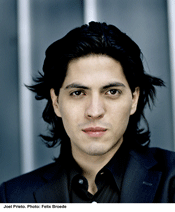 Joel Prieto [Photo by Felix Broede courtesy of Universal Music Classical Management & Productions]
Joel Prieto [Photo by Felix Broede courtesy of Universal Music Classical Management & Productions]
In his adult life, Mozart was at the receiving end of vicious political
jockeying and nasty pettiness he had no interest in mirroring. He still had an
unquenchable thirst for living, seeking outlets for his energies and potential.
In music, he found the only muse that would woo him. That tireless love for
music probably killed him, but before it did, he would have his fun attending
to and making it.
Mozart has gotten more attention recently from Palm Beach Opera. Così fan tutte, last seen here in 1998, completes PBO’s “Mozart-Da Ponte trilogy”; Le Nozze di Figaro and Don Giovanni were part of the company’s 2009 and 2010 seasons respectively. Two United States debuts highlight PBO’s second cast opening of Così on February 26th.
In his first opera conducting assignment in North America, Gianluca Martinenghi and orchestra distinguished themselves right from the overture with playing of the utmost delicacy, and sensitivity to Mozart’s score. This pattern held and generalized to the vocal department, buoying up and stimulating singing. A regular in some top theaters in Italy, the conductor’s pacing gave singers the prerogative to explore Da Ponte’s text. The playing did fall cold at the odd moment, but at the bridge to “Un Aura Amorosa” and for Fiordiligi’s second act aria, there was sufficient musical heat. Bruce Statsyna provided not simply chords, but accent notes, arpeggios, and runs underneath the vocal line on a healthy harpsichord.
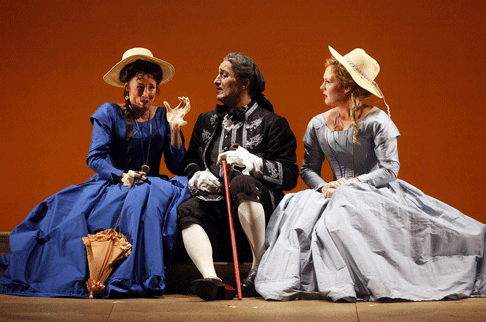 Dorabella (Patricia Risley), Fiordiligi (Caitlyn Lynch) and Don Alfonso (Matteo Pierone)
Dorabella (Patricia Risley), Fiordiligi (Caitlyn Lynch) and Don Alfonso (Matteo Pierone)
Joel Prieto had regular work in Europe before winning Operalia in 2008. His breakout came after that competition though, as he has appeared at Covent Garden, the Liceu, Stuttgart, and the Salzburg Festival. In his North American opera debut here, the Spanish born, Puerto Rican bred tenor left one wanting more. Prieto is building a characterization of Ferrando as that of a shy but curious fellow, one for which Mozart’s music is especially suited. Of the music, Prieto’s performance tended toward caution; “Un Aura Amorosa” was unexceptional but for the shading of the second stanza; at that point, and occasionally later, he sang with the kind of affinity for this music that has garnered him (much-too-early) comparisons with golden age aristocratic tenors. His tenor’s quality — amber hued and full, with an attractive fresh sheen — and size were bare in “Ah! Io veggio quell’anima bella.”
Caitlyn Lynch also took some time to warm up to Fiordiligi, achieving a “Per pieta, ben mio perdona” of unexpected commitment and feeling. Comedic points were hers (and Steven Lawless’) for departing the stage after the first part of “Come scoglio” and then reentering grandly for its concluding verse. PBO favorite Patricia Risley has the sort of creamily textured mezzo — however gummy the diction — and alluring physical presence that can shift the axis of focus in any performance; in this case the axis of Così’s “school for lovers” turned often to her Dorabella. The Guglielmo of Andrew Schroeder was especially susceptible to fading into the background in this production, though his resonant baritone would not go unnoticed. Matteo Pierone’s Don Alfonso began to take shape in the quintet — the highpoint of this Così’s ensemble singing — that closes Act One. From there on, his Alfonso played narrator, observing and commenting from the wings. As Despina, Abigail Nims’ impact was felt as a mysterious, masked dottore and later as a twitchy notary.
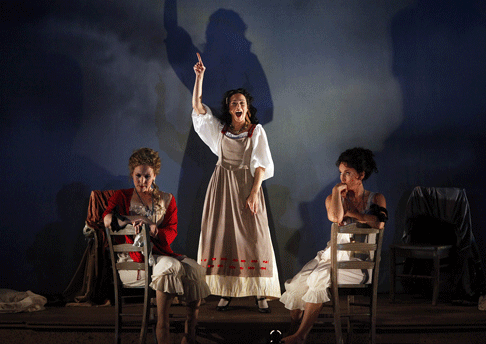 Fiordiligi (Caitlyn Lynch), Despina (Abigail Nims) and Dorabella (Patricia Risley),
Fiordiligi (Caitlyn Lynch), Despina (Abigail Nims) and Dorabella (Patricia Risley),
PBO’s chorus, under the direction of Greg Ritchey, created rich and sonorous music from offstage, emerging only for the civil ceremony.
Stephen Lawless’ permutation on Così’s magnet-as-poison-antidote theme was a kite-and-key electric conductor that had Ferrando and Guglielmo writhing and shuddering. Lawless moved the action upstage, in front of a scrim curtain of clouds as Alfonso re-pontificated to Ferrando and Guglielmo — their backs to the audience — “così” across Ferrando’s ear, “fan” across Guglielmo’s and “tutte” out into the theater. It is in the civil ceremony that Lawless’ stage direction hit a high-water mark that stayed mostly unbroken through much of Act Two. The scene included an action-stopping moment and then scurrying chorus members as the marriage contracts were signed. To close the opera, Fiordiligi and Dorabella crossed each other in confusion over which swain to go to in “Fortunate L’uom.”
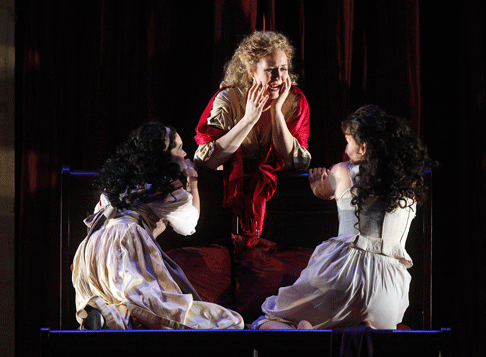 Despina (Abigail Nims), Fiordiligi (Caitlyn Lynch) and Dorabella (Patricia Risley)
Despina (Abigail Nims), Fiordiligi (Caitlyn Lynch) and Dorabella (Patricia Risley)
On loan from Atlanta Opera, Peter Dean Beck’s sets remember Classical Roman civilization and Naples; there are statues and columns and the sorelli are transplanted from their room to tanning on lounge chairs under an umbrella at a sun-soaked beach (Lighting by Michael Baumgarten). For a model of costume (owned by Atlanta Opera also) pragmatism we go to the final scene — designers at Malabar Ltd. cloak the “Albanians” in desert-beige trench coats, have them switch to floor length soldier uniforms, and back to the original desert gear, all in a flash.
This performance of Così will go down as an example of competent Mozart casting from PBO.
Robert Carreras
image=http://www.operatoday.com/_MG_6604.gif image_description=Dorabella (Patricia Risley) and Fiordiligi (Caitlyn Lynch) [Photo courtesy of Palm Beach Opera] product=yes product_title=W. A. Mozart: Così fan tutte product_by=Fiordiligi: Sabina Cvilak (2/25 & 2/27), Caitlin Lynch(2/26 & 2/28); Dorabella: (2/25 & 2/27), Patricia Risley (2/26 & 2/28); Ferrando: Norman Shankle (2/25 & 2/27), Joel Prieto (2/26 & 2/28); Guglielmo: David Adam Moore (2/25 & 2/27), Andrew Schroede (2/26 & 2/28); Despina: Abigail Nims; Don Alfonso: Matteo Peirone. Stephen Lawless, director. Gianluca Martinenghi, conductor. product_id=Above: Dorabella (Patricia Risley) and Fiordiligi (Caitlyn Lynch)Production photos courtesy of Palm Beach Opera
Schubert Transcribed, Wigmore Hall
This concert with Sandrine Piau, Antoine Tamestit and Markus Hadulla was very unusual indeed, shaking up assumptions about voice and instrument, styles and genres.
Sandrine Piau is an outstanding baroque specialist, renowned for her purity of her tone. A background in baroque develops clarity and precision, so her ventures into other repertoire build on these strengths. Her recordings of Debussy songs, for example, emphasize the transparent textures. It’s a very French aesthetic, lucidly beautiful. When Piau sings Schubert, her approach works well too. In An den Mond D 193 the lustrous sheen of her timbre evoked the moonlight, slowly traversing the landscape. The final strophe, “Dann, lieber Mond, dann nimm den Schleier wieder” was most effective, for her voice calls out, as if penetrating the darkness. Piau’s cool, abstract style sounds like a wind instrument, reinforcing the spirit of this unusual idiom-bending recital.
Nacht und Träume D.827 and Der Taubenpost D 965a are so famous as songs for voice and piano that it’s quite a surprise to hear them transcribed for viola, especially since the piano part remains much the same. It’s certainly not a question of what’s “better”, but more like hearing a completely alien “voice” with a unique personality. This was specially telling in the latter song where Tamestit’s viola catches the cheeky wit in the song, often missed when it’s performed as part of Schwanengesang. The viola does “sing”.
Then, Schubert as opera composer ! Romanze der Helene D 787 is an extract from Schubert’s Singspiele Die Verschworenen (The Conspirators). A recent performance in England was reviewed by Opera Today Schubert’s libretto is adapted from Aristophanes’ Lysistrata. This is the opening aria, expressing the heroine’s longing for her husband who is away at war. Piau sings it with such feeling that you’re won over, though the war in question was the Crusades which are normally romanticized in Christian Europe.
Die Verschworenen isn’t familiar except to Schubert devotees, but Der Hirt auf dem Felsen (The Shepherd on the Rock) D.965 is one of his best loved songs. It’s quite a shock to hear that evocative, curving introduction with viola instead of clarinet. Bowing instead of blowing ! But once you adjust, it’s fascinating. Then Piau starts to sing the swooping, elliptical lines that represent the way shepherds project their voices over mountains and valleys. In your imagination, you “hear” the way a bow glides back and forth across strings. Schubert, but not quite as we know him. You can always rely on the Wigmore Hall to promote adventurous recitals. This concert with Sandrine Piau, Antoine Tamestit and Markus Hadulla was very unusual indeed, shaking up assumptions about voice and instrument, styles and genres. Vocal glissandi. Uncanny, the way our senses can cross reference each other.
Keynote of this recital was Schubert’s Arpeggione Sonata D.821. It’s seldom performed live as the arpeggione is an antique instrument few can play. It’s fretted like a guitar but bowed like a cello. The instrument was invented by a guitar maker in 1823, so when Schubert wrote the sonata in 1824, he was pioneering completely new territory. In his own time, Schubert was avant garde.
Nonetheless, Schubert’s affinity for the guitar was rooted fairly deep in his life. I’m not sure if he played the instrument, but it was popular in 19th century Austria and played in social situations. Hugo Wolf’s mother was a keen amateur guitar player, influencing Wolf’s music to a greater degree than is often realized. I don’t know if Schubert played the guitar, but he would have been familiar with it and the situations in which it was played. There have been notable transcriptions of Schubert works adapted for guitar, such as like Die schöne Müllerin D. 795, which work extremely well. No wonder he was attracted to the arpeggione.
The trouble is, the new instrument didn’t catch on and there’s almost nothing written for it in the repertoire. The Arpeggione Sonata is rarely heard except in transcription for cello. Antoine Tamestit’s transcription for viola is fascinating because the viola is smaller and lighter. Four strings instead of the apreggione’s six, but less body than a cello. I’m not sure what viola Tamestit was using, but he produces a lithe, flexible sound. Like guitars and presumably arpeggiones, violas are portable, so Tamestit’s freedom brightens the piece and makes it move, perhaps as Schubert might have imagined it.
This very unusual programme was compiled by Antoine Tamestit, a violist whose original transcriptions of various Schubert staples are now available on CD from the French label Naive. Sandrine Piau appears on the recording as well, so that singular Der Hirt auf dem Felsen (The Shepherd on the Rock) D.965D is preserved for all to enjoy.
Anne Ozorio
image=http://www.operatoday.com/Sandrine_Piau.gif
image_description=Sandrine Piau [Photo by Antoine Le Grand courtesy of IMG Artists]
product=yes
product_title=Schubert Transcribed
product_by=Sandrine Piau, soprano; Antoine Tamestit, viola; Markus Hadulla, piano. Wigmore Hall, London, 28 February 2011.
product_Id=Above: Sandrine Piau [Photo by Antoine Le Grand courtesy of IMG Artists]
Ariadne auf Naxos, Bordeaux
The opera’s prologue got us pretty concerned about exactly how the Strauss/von Hofmannsthal conceit (superimposing improvised comedy on high art tragedy) would play out. It was going to happen in some sort of distressed art space where some pretty bad art (a huge, plastic sculpture) had been lifted out to make space for more, we assumed, bad art (“performance art” is at least naughty if not usually bad).
But all this turned out to be a high flying artistic extravaganza. Its riches were three fold — first it is a big opera with three great roles for sopranos, second there were three great sopranos, and third Bordeaux gave the opera a mise en scène that played with its complexities and reveled in its fun.
Performance art is as close as we come these days to commedia dell’arte, so this transcription of art form was well taken, plus performance art seems to question the nature of art more than it questions anything else and this led metteur en scène Roy Rallo to probe the depths of this silly Strauss/von Hofmannsthal tragedia cum commedia and to find out that it is in fact a fairly serious artistic treatise.
The ubiquitous wreck of a cheap sofa that inhabits most performance spaces here headquartered Najade, Dryade and Echo in various prone positions while stage hands poured buckets of dirt over them, Ariadne was seated in the neon tube outlined sand box, with the remnant, a small head (remember the huge sculpture in the prologue), of a dog’s toy that was the minotaur, and Theseus too. Echo outlined the minotaur head on the ubiquitous performance space white wall during Ariadne’s lament, and later seconded the forceful horn announcements of Bacchus’ arrival with determined throws of her yoyo. More dirt was poured on Najade and Dryade.
When it was Zerbinetta’s turn in the sand box she sang her ravishing parody in nightclub garb only to be sexually ravaged by the comedians (painting her in lurid colors). When she became Harlequin’s wife in an American gothic tableau during Ariadne’s prayer we understood all too well that all this was the trappings of ordinary, everyday mortal love in contrast to the grandiose ideal of love sought by Ariadne.
Well, Bacchus arrived and we had Orpheus and Euridice all over again. In reverse. When their gaze finally met it was all over, Bacchus disappeared into the void (all the doors onto the stage burst open — out the back we even saw the building across the street) and Ariadne was left alone on the stage as the beat-up Zerbinetta with her sad Harlequin husband exited through a side door into a snow storm.
So, all this was art, but what about life? That was of course Strauss’ Composer who had a bitter artistic pill to swallow, though this young composer thought he had found a soul mate in Zerbinetta, and he poured his heart out about it, only to be first of the opera’s lovers to learn that true love is not to be had in this life. Just then there was a bonus: the Opéra National de Bordeaux enriched Strauss’ ridiculous concoction by superimposing an operatic whim of its own — real time, curtain calls onto the prologue!
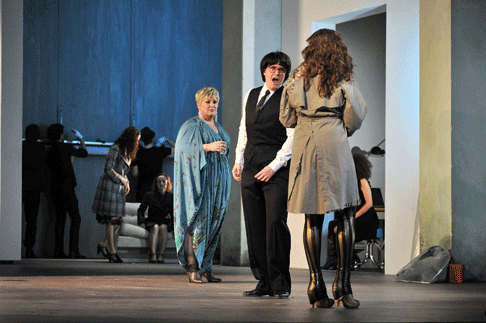 Heidi Melton as Ariadne, Elza van den Heever as The Composer and Brenda Rae as Zerbinetta
Heidi Melton as Ariadne, Elza van den Heever as The Composer and Brenda Rae as Zerbinetta
Marsha Ginsberg gave detailed design to the sets, the dirty walls and chipped tiles of a very realistic building blurring the boundaries between art and real life, and costumer Doey Lüethi further complicated this distinction with real clothing that sometimes screamed character. Lighting by Chris Akerlind cannily intermixed the real and the arty, the flashing red and green lights during the opera’s final sublime love music reminding us that all this was, said and done, performance art confusing itself with art.
Yes, it took the considerable artistry of three exquisite sopranos to pull this off. Elza van den Heever (Composer), Heidi Melton (Ariadne) and Brenda Rae (Zerbinetta) are new generation artists with beautiful, fresh and well-schooled voices that illuminate amazing histrionic depth with elegant artistry. Mlle. van den Heever literally tore up the stage in her aria. Not to mention that Zerbinetta tore up the stage as well, standing motionless for her aria, and Heidi Melton brought real gravity to the opera’s opera, sitting with her back against the wall, her legs splayed downstage, her voice lofting torrents of gorgeous tone.
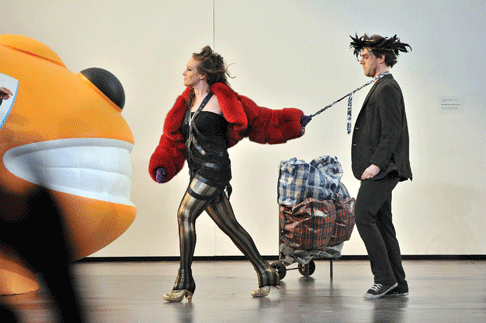 Brenda Rae as Zerbinetta and Thomas Dolié as Harlequin
Brenda Rae as Zerbinetta and Thomas Dolié as Harlequin
Conductor Kwamé Ryan drove the big moments of the opera to maximum Straussian effect, and that effect was considerable indeed, though precision and energy were wanting in the detail that Strauss lavishes on his musical story telling. This was most noticeable in the Prologue, though it is possible that this Prologue’s laxity was also the result of the heavy-handed exposition of the performance art metaphor.
The Harlequin, sung by baritone Thomas Dolié, created the evening’s most touching moments, approaching Ariadne’s sandbox with his arms outstretched during her lament, and then as Zerbinetta’s forlorn husband. The Music Master was confidently portrayed by Oliver Zwarg. Actor Martin C. Turba as the Major-domo seemed to be at odds with the musical and staging rhythms of the Prologue further deadening it. Tenor Arnold Bezuyen as Bacchus confused bellowing with singing. Najade (Mélody Loulejian), Dryade (Leslie Davis) and particularly Echo (Eve-Christophe-Fontana) brought fine singing and much pleasurable deadpan perspective to Ariadne’s suffering.
Michael Milenski
image=http://www.operatoday.com/Ariadne_ONB_03.gif
image_description=Heidi Melton as Ariadne [Photo by Frédéric Desmesure courtesy of Opéra National de Bordeaux]
product=yes
product_title=
product_by=Le Majordome: Martin C. Turba; Ariane: Heidi Melton; Le Compositeur: Elza van den Heever; Le Maître de Musique: Olivier Zwarg; Le Maître à danser: Olivier Dumait; Scaramouche: François Piolino; Ténor/Bacchus: Arnold Bezuyen; Zerbinette: Brenda Rae; Harlequin: Thomas Dolié; Brighella: Xin Wang; Truffaldin: Andrey Zemskov; Naïade: Mélody Louledjian; L’Echo: Eve Christophe; Dryade: Leslie Davies; Le Laquais: Pascal Wintzner; Le Perruquier: David Ortéga; L’Officier: Olivier Bekretaoui. Direction musicale: Kwamé Ryan. Mise en scène: Roy Rallo. Décors: Marsha Ginsberg. Costumes: Doey Lüthi. Lumières: Christopher Akerlind.
product_id=Above: Heidi Melton as Ariadne
All photos by Frédéric Desmesure courtesy of Opéra National de Bordeaux
March 5, 2011
Roméo et Juliette, Philadelphia
Fifty years ago performances were heavily cut, as much of the music lacks dramatic punch. The idiomatic Italo-French performance style in which it was written has all but died out. Its libretto bowdlerizes Shakespeare.
Yet a number of memorable arias and duets—and the reflected glory of the Bard—have kept Roméo alive. It is, moreover, widely viewed an appropriate vehicle for young and visually appropriate singers with medium-weight voices—though perhaps wrongly, since the greatest Roméos have included Jean de Reszke, Georges Thill, Jussi Björling, and Franco Corelli. The opera is thus intermittently revived when fresh new talent is at hand.
Such was the case this month at the Philadelphia Opera, which cast Ailyn Pérez and Stephen Costello as the stat-crossed lovers. Pictures of the good-looking couple, shot at an all-day session last summer, made for effective publicity. Pérez and Costello were on the airwaves and web, recounting their story of having graduated from Philadelphia’s Academy of Vocal Arts and becoming real-life husband and wife in 2008. Both are rising quickly in the opera world. Costello will join Anna Netrebko and Elīna Garanča for his second opening night at the Met next fall. Pérez has been singing in Berlin, Vienna, London and La Scala.
This casting was evidently insufficient to assure a box-office hit, so the company imported producer Manfred Schweigkofler from Italy. His big concept was to reset the story as a modern-day haute couture battle between rival Capulet and Montague fashion houses. The idea is not as radical as it might sound. Modern Shakespeare adaptations are old hat after Baz Luhrmann’s diverting (if not deep) film Romeo+Juliet and the Shakespeare Retold version of Macbeth, with its warring chefs. Opera Company of Philadelphia has had good luck in the past with modernized productions, most notably its wonderfully whacky 1950s Cenerentola a few years back, which opened with Angelina pushing around a vacuum cleaner.
Some local critics were hostile. True, this Juliet was more Versace than virgin, the modern setting belied the Victorian-era text, and some subtleties of Gounod’s score were obscured by overly energetic stage activity. Yet I found the fashionista concept dramatically engaging. Why not portray Juliette as a teenage House of Capulet model, play her Dad as the head designer, center the Capulet party on a group of runway models parading new outfits, deliver the poison in a martini glass, let paparazzi swarm around the stage, stage fights with golf clubs not swords, and set paper boys loose through the audience delivering tragic news? Schweigkofler has, moreover, a keen sense of color and line; the set, designed by Nora Veneri, looked great, even if the stage business taking place on it could be cloying. The unit set was clearly built to be inexpensive. No doubt the production concept helped sell out the house, create buzz, and stimulate community involvement—since fashion students from three local universities designed outfits for the party aka runway show.
Yet in the end, of course, Roméo needs to sell itself on the singing of its leads. Both seemed to take a while to warm up, or simply felt more comfortable in later acts. Costello’s famous second-act aria, “Ah, lève-toi soleil!,” was short-breathed and dynamically imprecise. Thereafter he seemed to settle down, displaying more subtle dynamics and phrasing—though his timbre often retained a pressed, somewhat monochromatically metallic “young tenor” sound, with the (often conjoined) tendency to slide off pitch. There is little doubt, nonetheless, that this is an exceptional voice of real promise, with true Italianate virtues: squillo, ringing high notes, and some ability to mix head and chest tones. His French was adequate.
Pérez is the more energetic stage presence. As happens with many young sopranos, her voice is now moving beyond the lyric coloratura roles in which she has specialized to date. She was least comfortable in the famous Act I showpiece, but, like Costello, she seemed warm into the role thereafter. Like him, also, her voice can be cooler and more metallic than one might wish; I found the bottom of the voice more attractive. Yet there is little doubt that this is a gifted, smart and technically accomplished singer with a potentially important career ahead of her. The duets, as one might perhaps expect from a married couple, were well-rehearsed.
The other members of the ensemble were strong, particularly fellow AVA graduate Daniel Mobbs as Capulet, but also Romanian baritone Marian Pop, Italian mezzo Elena Belfiore, and three other young singers with Philadelphia connections: Olivia Vote, Taylor Strayton, and Justin Hopkins. The chorus sang lustily and the orchestra, a weak link in many Philadelphia performances, surpassed its usual standard under the unaccustomed baton of the New Jersey Symphony Orchestra’s new Music Director, Jacques Lacombe.
Andrew Moravcsik
image=http://www.operatoday.com/Romeo_and_juliet_brown.gif image_description=Romeo and Juliet by Ford Maddox Brown (1870) [Source: Wikipedia] product=yes product_title=Charles Gounod: Roméo et Juliette product_by=Romeo: Stephen Costello; Juliet: Ailyn Pérez; Mercutio: Marian Pop; Stéphano: Elena Belfiore; Capulet: Daniel Mobbs; Gertrude: Olivia Vote; Tybalt: Taylor Stayton; Duke of Verona: Frank Mitchell; Friar Laurent: Justin Hopkins; Gregario: Jeffrey Chapman; Paris: Siddartha Misra; Benvolio: Paul Vetrano. Opera Company of Philadelphia. Conductor: Jacques Lacombe. Director: Manfred Schweigkofler. product_id=Above: Romeo and Juliet by Ford Maddox Brown (1870) [Source: Wikipedia]March 1, 2011
Die Fledermaus, Wales Millennium Centre, Cardiff
By Andrew Clark [Financial Times,1 March 2011]
The British have almost as big a problem with Viennese operetta as they do with French. It’s a question of style and tone. Sung in English, Die Fledermaus invariably turns into an old-fashioned comedy of class, with cut-glass accents for Eisenstein and his cronies and something “regional” for Frosch the gaoler. It never works, because even a century ago the English upper class had nothing like the insouciance of Johann Strauss’s haute bourgeoisie. The comedy ends up stiff and contrived.